Friday Philosophicals Archives Fall 2017-Winter 2022
Academic Year 2022-2023
Schedule for 2022-2023
March 31, 2023
Sarah Santos: The evolutionary history of iconic North American sheep
 Supervisor: Dr. David Coltman
Supervisor: Dr. David ColtmanThe increased accessibility of nuclear whole-genome sequences (WGS) allows us to explore the evolutionary processes underlying the relationships among species. Here I aim to study such processes using multiple WGS of wild thinhorn (Ovis dalli) and bighorn sheep (O. canadensis). Thinhorn sheep comprise the dark pelage Stone (O. d. stonei), whose coat color resembles a bighorn, and the pure white Dall (O. d. dalli). Their speciation arose from geographical separation with potential hybridization, and I assessed how evolution shaped their genomic patterns. Hybridization signals between Stone and bighorn were more frequent throughout the genomes than between Dall and bighorn. Moreover, we found a frameshift mutation in a coat color-related gene, which was only present in Dall. These findings illustrate that hybridization between Stone and bighorn either maintained or developed the darker pelage in Stone, while Dall developed its white pelage. Taken together, these results more fully illuminate their evolutionary history.
Richard Nguyen: Do N-heterocyclic carbenes protect against microbial corrosion of mild steel?
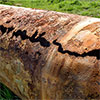 Supervisor: Dr. Vera Tai
Supervisor: Dr. Vera TaiCorrosion is estimated to cost the global economy 2.5 trillion USD annually and is often influenced or enhanced by microorganisms accounting for 20% of total costs. While corrosion-resistant coats are an inexpensive and effective method of mitigating corrosion, they are susceptible to disbondment from the metal surface. Newly synthesized N-heterocyclic carbenes demonstrate the potential to reduce corrosion and increase adhesion between corrosion-resistant coats and the metal surface. For my thesis, I will investigate whether carbene-coated metal can protect against microbial-influenced corrosion. I will expose carbene-coated metals to pure cultures of corrosion-causing Pseudomonas fluorescens and Desulfovibrio vulgaris and investigate changes in the metal surface using microscopy and spectroscopy techniques. I will also extract and sequence RNA from the biofilm to examine changes in corrosion-related gene expression in the bacteria. This research will help assess the efficacy of N-heterocyclic carbenes in reducing corrosion and contribute to the development of corrosion-preventative techniques.
Makayla Lloyd: Bioprospecting: Investigating the toxic droplets of Pleurotus species
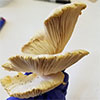 Supervisor: Dr. Greg Thorn
Supervisor: Dr. Greg ThornIn recent years, several genera of carnivorous fungi have been shown to possess diverse mechanisms which trap and digest microfauna as a means of nutrient supplementation. Of these fungi, Pleurotus—commonly known as the oyster mushroom—possesses the unique ability to paralyze nematodes through the production of toxic secondary metabolites. These metabolites are contained within liquid microdroplets produced on aerial hyphae, which burst when disrupted by passing nematodes, paralyzing them for fungal consumption. Although recent attempts have been made to identify this toxin in primary literature, the identity of Pleurotus toxin has not yet been found. Similarly, research focusing on the details of droplet production and their effects on nematodes has been conducted predominantly on one species, P. ostreatus. My proposed research aims to understand both the toxin droplet production between species and strains of Pleurotus, and uncover the chemical composition of the toxin droplets using GC-MS.
March 24, 2023
Aaya Aboulnaga: The effect of species reintroduction on the genetic diversity of the mottled duskywing butterfly (Erynnis martialis)
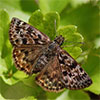 Supervisor: Dr. Nusha Keyghobadi
Supervisor: Dr. Nusha KeyghobadiWhen conserving a species, consideration should be given to protecting the underlying genetics, and not just the number of individuals. A project to reintroduce the mottled duskywing butterfly (Erynnis martialis) to a reconstruction of its former habitat is underway in southern Ontario, where individuals are captured from an extant population so that their offspring can be used to establish the new population at the release site. The limited starting size of the new population and the removal of individuals from the source makes both populations of this endangered species vulnerable to loss of genetic diversity, as they are susceptible to genetic drift, loss of evolutionary potential, and at risk of experiencing inbreeding depression. For my MSc, I will use microsatellites to monitor the genetic diversity of both populations over the course of the reintroduction program to see the effects of the translocation of individuals on the populations involved.
Eileen Reinke: Utilizing cover crop mixtures to promote resilient soil health and potato yields
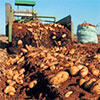 Supervisors: Dr. Zoë Lindo and Dr. Cameron Wagg
Supervisors: Dr. Zoë Lindo and Dr. Cameron WaggAgricultural soils are depleted of biodiversity limiting the functioning of agroecosystems. Cover crop mixtures can benefit ecosystem services and subsequent cash crop yield; however, cover crop mixtures do not always provide such benefits, highlighting the need to understand the interactions of component plants in mixtures and the mechanisms related to increased cash crop yields. My proposed research will contribute to our understanding of interactions of plants in functionally diverse cover crop mixtures and the mechanisms that support the yield of a subsequent cash crop. My proposed research will also evaluate the potential of cover crop mixtures to restore the soil following intensive potato cash cropping with a focus on soil biota that drive agroecosystem functioning that are often neglected from soil health assessments. This knowledge will contribute to supporting ongoing research to make agricultural production systems more sustainable in Atlantic Canada.
Pedro Conceicao: Post-glacial patterns of predatory mites across a peatland latitudinal-successional gradient
 Supervisor: Dr. Zoë Lindo
Supervisor: Dr. Zoë LindoIn Earth’s 4.5-billion-year history the last century has proved an unprecedented period of rapid change driven by multiple and co-occurring anthropogenic-induced climate change factors. These rapid changes are anticipated to have broad and significant impacts on many species and the processes that structure ecological communities. Peatlands are often used to examine patterns of glacial retreat as they form ‘relic’ landscapes across a wide ice retreat gradient and are also habitat for species rich communities of soil-dwelling arthropods, such as mites. The predatory mites (Class Mesostigmata) are small, wingless arthropods very understudied in peatland systems. My research will explore the structure of mesostigmatid mite communities in Sphagnum peatlands across a latitudinal-successional gradient in Ontario investigating the factors underlying their composition.
March 17, 2023
Katarina Kukolj: Investigating the effects of the Blewit mushroom Lepista nuda on the community composition of its soil environment
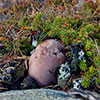 Supervisor: Dr. Greg Thorn
Supervisor: Dr. Greg ThornI’m investigating the effects of the edible Blewit mushroom (Lepista nuda) on the community composition of its soil environment in coastal regions of Newfoundland, Canada. Previous studies on Blewits have discovered their antimicrobial properties in the lab, but there have been no field studies to observe how soil and the organisms in it could be changed by growth of Blewit mycelium in their natural environment. This study includes sampling soil at various time points from known natural Blewit patches and nearby treatment plots inoculated with Blewit mycelium, in comparison to plots without Blewits. Arthropod, nematode, bacterial and fungal members of the soil community will be identified and their relative abundance determined by DNA extraction and metabarcoding analyses. These results will tell us how Blewit mycelium changes soil communities and if potential crop pests/pathogens are significantly reduced, essential for understanding their potential in the agricultural industry as a biopesticide and co-crop.
Mehra Balsara: The response to hunter-induced selection on horn characteristics and coat colour in thinhorn sheep Ovis dalli
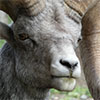 Supervisor: Dr. David Coltman
Supervisor: Dr. David ColtmanSelective harvesting through trophy hunting can have serious consequences towards the maintenance of genetically healthy populations. Often this hunting results in a reduction in size for secondary sexual characteristics (i.e. horns, antlers, tusks). To better understand the artificial selection pressures associated with trophy hunting, I will calculate the predicted evolutionary response to selection for two phenotypic traits (horn growth and horn morphology) in a popular trophy hunted ungulate, thinhorn sheep (Ovis dalli). I will then define how the selection pressures acting on each of these traits influence the genetic structure of this species. To address these objectives, I created a custom SNP array that will be used to genotype individuals, calculate heritability and assess trait and gene associations. This research will help identify the impact of harvesting selection on trait variation and determine how harvesting can be more sustainable to ensure the conservation of thinhorn sheep.
March 10, 2023
Kiana Lee: The effects of warming on floral traits
 Supervisors: Dr. Danielle Way and Dr. Jeremy McNeil
Supervisors: Dr. Danielle Way and Dr. Jeremy McNeilPollination is an essential ecosystem service that is necessary for the reproduction of flowering plants; however, climate warming could affect floral traits that are essential for pollination. My objective is to investigate how floral traits that are important for pollinator attraction change when cucumber plants are grown at ambient or ambient +4°C temperatures. To address this, I measured the size of UV floral guides (signals to pollinators that are only visible under UV wavelengths of light) using UV-visible photography. I also identified changes in the composition and concentration of floral flavonoids (compounds absorbing UV light). Finally, I correlated changes in key floral traits with flower development and plant growth. From this research I will be able to determine how warming can alter how pollinators are attracted to flowers and thus provide pollination services.
Jessica Stokes-Rees: Early-season cover crops prior to spinach planting provide co-benefits for the soil invertebrate community
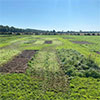 Supervisors: Dr. Ian Scott and Dr. Hugh Henry
Supervisors: Dr. Ian Scott and Dr. Hugh HenryCover crops are recognized as a best management practice in agriculture because they can reduce the need for tillage, herbicides, and fertilizer. Cover crops also can reduce soil erosion, protect soils from weed invasion and, when terminated, increase soil organic matter. The effect of tillage on soil invertebrate diversity and abundance is well documented; however, few studies have addressed how soil invertebrate diversity and abundance respond to cover crop use. My research has focused on differences in invertebrate abundance in response to different cover crop and tillage practices used for cool-season vegetable production. The abundance of earthworms, a keystone species of soil habitats, was significantly higher in plots with cover crops compared to plots that were tilled. Similarly, cover crops increased the abundance and diversity of arthropods. My results suggest that cover crops increase the abundance of beneficial soil organisms, which can contribute to increased resilience of agroecosystems.
Cristina Turcu: Microbial community response to experimental warming in boreal peatlands
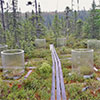 Supervisor: Dr. Vera Tai
Supervisor: Dr. Vera TaiBoreal peatlands are essential in global carbon cycles and storage as waterlogged, anoxic, acidic and low temperatures limit rates of decomposition by microbial communities. However, these conditions are predicted to change due to climate change, potentially altering decomposition processes such that peatlands become carbon sources. Microbial communities are particularly important for decomposition, and climate change will undoubtedly shift microbial biomass and composition. Measuring microbial biomass using PLFA analysis gives vague functional and taxonomic details and are not optimized for organic-rich soils. Using ambient and experimentally warmed plots, I will quantify differences in microbial biomass and community composition, using quantitative PCR (qPCR) and metabarcode sequencing respectively, and compare qPCR and PLFA to see if they are analogous measures of biomass. This will provide estimates for changes in microbial community composition and biomass and validate qPCR as a measure of microbial biomass in peatlands.
March 3, 2023
Samantha Hopkins: Experimental climate warming on Sphagnum traits and community composition in boreal peatlands
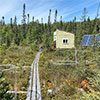 Supervisor: Dr. Zoë Lindo
Supervisor: Dr. Zoë LindoBoreal peatlands store carbon as partially decomposed plant matter (peat), with most plant inputs coming from the Bryophyte genus Sphagnum. Sphagnum are ecosystem engineers, altering the hydrology, chemistry, and topography of boreal peatland landscapes to foster their own growth. Within the Sphagnum genus, trait variation exists among species based on habitat preferences related to factors like temperature. As climate change continues to warm the boreal forest zone, community composition shifts in Sphagnum may occur as certain traits become a disadvantage under increasing temperatures. For my MSc, I will attempt to identify how temperature increases affect species traits and community composition under an experimental warming regime; to do this, I will conduct a growth experiment on three Sphagnum species with different habitat preferences and use community composition data in conjunction with Sphagnum traits from the literature to disentangle the mechanisms driving community shifts.
Melina Kuerschner: The Effects of Forest Fire Smoke on Migratory Bird Respiratory Physiology and Flight Performance
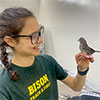 Supervisors: Dr. Chris Guglielmo and Dr. Yolanda Morbey
Supervisors: Dr. Chris Guglielmo and Dr. Yolanda MorbeyFor my PhD entry talk I will present the current plan for my thesis. I have decided to focus my project on the effects of forest fire smoke on migratory bird respiratory physiology and flight performance. Due to climate change, the incidence of wildfires has been rapidly increasing. This can have dire consequences for wildlife, many of which have not yet been studied or even discovered. My hypothesis is that birds exposed to airborne contaminants will exhibit reduced ventilatory capabilities and impeded flight exercise performance when compared with control birds. I will do this for both an acute and a chronic treatment, to simulate a polluted migration stopover site and a polluted breeding site, respectively. To evaluate the acute effects of poor air quality, I will study wild-caught yellow-rumped warblers and for the chronic effects I will use homing pigeons, as warblers do not breed well in captivity.
Rachel Rajsp: Investigating the soil mycobiome of American ginseng (Panax quinquefolius)
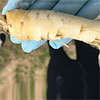 Supervisor: Dr. Greg Thorn
Supervisor: Dr. Greg ThornAmerican ginseng (Panax quinquefolius) is a perennial plant that has been used for centuries in herbal medicines. Due to the rise in demand of wild ginseng the species became classified as endangered while poaching has increased. Instead, field grown ginseng was used as an alternative cultivation method. In field, a disease arose in new ginseng crops that were planted in the same field that ginseng had been previously cultivated. This phenomenon is referred to as ginseng replant disease (GRD). GRD poses a threat to growers across North America as the field sites that contain uncultivated soil are limited. My project investigates alternative fungal identification methods using a modified DNA extraction protocol customized for sandy-loam soil, primers that provide better species resolution (full ITS and TEF region) and compare the mycobiome across several time points in ginseng cultivation and beyond harvest to be used as a potential diagnostic tool for growers.
February 17, 2023
Campbell McKay: Do some species of milkweed better prepare monarch butterflies for migration?/em>
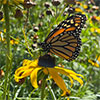 Supervisor: Dr. Jeremy McNeil
Supervisor: Dr. Jeremy McNeilFor many insects, the quality of the larval diet can have lasting effects that will impact adult mass, morphology, and timing. For their larval hostplant, the monarch butterfly (Danaus plexxipus) exclusively exploits milkweeds (Asclepias spp). While breeding generation diets are well studied, how these different species of milkweed prepare migratory generation monarchs for their flight to Mexico remains understudied. Last summer, I reared monarch butterflies on three local species of milkweed: common milkweed (Asclepias syriaca), swamp milkweed (Asclepias incarnata), and butterfly milkweed (Asclepias tuberosa). By directly measuring larval consumption on measured cuttings of leaves in parallel to monarchs reared directly on plants outdoors, I hoped to compare how adults reared on different diets differed in development time, mass, lipid mass, wing surface area, and wing loading, with a focus on how these traits may prepare them for migratory flight.
Scout Thompson: Random mating in the face of balancing selection at class I of the major histocompatibility complex (MHCI) in Song Sparrows (Melospiza melodia)
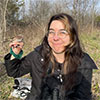 Supervisor: Dr. Beth MacDougall-Shackleton
Supervisor: Dr. Beth MacDougall-ShackletonSexual selection is a major catalyst driving the evolutionary trajectory of certain genes. The major histocompatibility complex (MHC), a set of genes providing the ability to detect pathogens, is no exception to this – with many species demonstrating non-random mating at these loci. In song sparrows, it was shown that birds tend to mate with genetically similar individuals at MHC class II (MHCII), the subset that detects extracellular pathogens. However, whether non-random mating occurs at class I (MHCI), which detect intracellular pathogens, was previously unknown. Despite my prediction that mate pairs would be more genetically dissimilar, due to the positive relationship between fitness and MHCI allele number, my work has instead shown a system of random mating. Curiously, I have also found balancing selection operating at these loci, suggesting that non-random mating would confer a fitness benefit but is not occurring - presumably due to an inability to detect MHCI genotype.
February 10, 2023
Cailyn McKay: Heat stress experienced during metamorphosis: Impacts on pheromone-mediated mating in the true armyworm (Mythimna unipuncta)
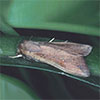 Supervisor: Dr. Jeremy McNeil
Supervisor: Dr. Jeremy McNeilInsect body temperature is often managed by individuals moving to more suitable microhabitats, an option not possible for the sedentary egg and pupal stages. Consequently, these are at greater risk of heat stress during heatwaves. I used the true armyworm (Mythimna unipuncta) to examine the effects of short-term heat stress during several stages of pupal development on subsequent adult reproduction. Heat stress significantly reduced the number and fertility of eggs, especially when it occurred in early development. In part this was due to a reduction in mating frequency, suggesting that pheromone-mediated communication was affected. I will determine if pupal heat shock affects the production and detection of sex pheromones by both sexes, as well as female calling behaviour. The findings will not only add to our understanding potential impacts of climate change on pheromone mediated communication, but are of practical importance as pheromones are used in many pest management programmes.
Julien Koga: Improved production of erinacine A by North American Hericium species in submerged liquid culture fermentation
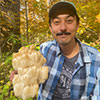 Supervisor: Dr. Greg Thorn
Supervisor: Dr. Greg ThornHericium erinaceus is a choice edible mushroom that produces a variety of bioactive metabolites. Erinacines, produced in the mycelium, are capable of stimulating nerve growth factor (NGF) synthesis and are being considered as therapeutic treatments in diseases associated with NGF-deficiency such as Alzheimer’s and Parkinson’s Disease. However, there is a significant lack of understanding of the production of erinacines in other species of Hericium, four of which occur in North America. This project will evaluate the production of erinacines by wild-harvested North American Hericium species in submerged liquid culture fermentation and aim to optimize their culture conditions for improved yields of erinacine A and mycelial biomass.
Justin To: Love is in the oil, and it reeks of immunity
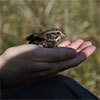 Supervisor: Dr. Beth MacDougall-Shackleton
Supervisor: Dr. Beth MacDougall-ShackletonSexual selection reinforces parasite-mediated natural selection, maintaining genetic diversity in host populations. This was described in the Major Histocompatibility Complex (MHC) immune gene family; and now in the Toll-Like Receptors (TLR) gene family. Individuals can assess variation in MHC through olfaction, this was first described in mammals and more recently in birds. Bird preen oil is the major source of avian body odour, and in song sparrows it was shown to covary with MHC profiles and birds can detect these differences. Recently, non-random mating was observed in TLR genes in song sparrows (Melospiza melodia). Alongside this TLR genes interact with preen gland microbial communities, these factors suggest TLR may also be communicated to conspecifics through preen oil odour. I will be testing this relationship using pairwise matrices of Bray-Curtis dissimilarity to determine if TLR gene variation at 2 different loci correspond with preen oil chemical composition.
February 3, 2023
Ryan Conklin: Slow and steady or fast and productive? The association of migration distance on pace of life in song sparrows
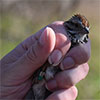 Supervisor: Dr. Beth MacDougall-Shackleton
Supervisor: Dr. Beth MacDougall-ShackletonPace of life syndrome is an extension of life history theory that focuses on how trade-offs between reproduction and survival are affected by ecological pressures. Migration is one such pressure and in many species of birds, individuals are known to migrate distinct differences relative to conspecifics. Despite pace of life likely having an association with migration distance, as a consequence of short and long-distance migration having differences in both time and energy expenditure and overwintering conditions, such associations remain poorly understood at the individual level. I will be using a combination of overwinter survival rates and deuterium values collected from claw tissue, a proxy for migration distance, to elucidate individual differences between migration distance and its association with pace of life in a population of song sparrows (Melospiza melodia) in southern Ontario. Initial data analysis indicates individuals do migrate distinct distances and have differing survival rates.
Sophie Killam: The potential for gut microbes to affect honey bee hygienic behaviour
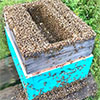 Supervisor: Dr. Graham Thompson
Supervisor: Dr. Graham ThompsonHygiene is a social behaviour of honey bees that protects the hive against pathogens and parasites: hygienic bees detect dead or diseased brood via olfactory cues and remove them to prevent the spread of infection within the colony. Lowering the response threshold at which nurse bees detect infection would effectively increase hygiene, thereby improving colony health. One mechanism to potentially manipulate the hygienic threshold is the brain-gut axis – a proposed bi-directional pathway that links an organism’s gut to its nervous system, brain, and behaviour. For my MSc, I will use a field experiment to manipulate the gut microbiota of whole living colonies then measure any effect on hygiene. I will also test for brain-gut axis effects on the gut and brain directly by sequencing gut microbe composition and imaging bee brains.
January 27, 2023
Ala Abdel Rahman: Combined use of cover crops and the entomopathogenic fungus Metarhizium brunneum to manage wireworm
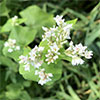 Supervisor: Drs. Ian Scott and Hugh Henry
Supervisor: Drs. Ian Scott and Hugh HenryWireworms, the larval stage of click beetles (Coleoptera: Elateridae), is a major pest of potatoes and other horticultural and field crops globally. Agricultural practices that promote resilience include the use of cover crops in the rotation since they are effective at suppressing soil pests and disease, retaining soil moisture and nutrients, and contribute to overall soil health. Cover crops plants that release allelochemicals or act as fumigants can reduce the wireworm population. A new biopesticide developed from Metarhizium brunneum an entomopathogenic fungus of wireworms, also shows promise, potentially in combination with insecticides and cover crops.
Trevor Pettit: Carbon flux in soil food webs depends on warming and hydrological changes to boreal peatlands
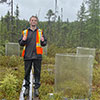 Supervisor: Dr. Zoë Lindo
Supervisor: Dr. Zoë LindoBoreal peatlands play an important role in terrestrial carbon (C) storage. At northern latitudes, soil temperature and moisture conditions under climate change are predicted to become more extreme and more variable. Temperature and hydrology play an important role in regulating decomposition and ecosystem functioning, like C sequestration, in boreal peatlands. The objective of my MSc research is to quantify and model the effects of experimentally imposed temperature and moisture conditions that simulate potential future climate, on peatland soil food webs and soil C fluxes. Preliminary results suggest that increases in temperature may drive increases in total C fluxes and C mineralization, while increases in soil moisture may drive decreases in total C fluxes and C mineralization.
January 20, 2023
Andrew Beauchamp: Migration physiology and behaviour: understanding the interaction between individual and environment
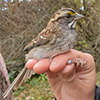 Supervisor: Drs. Chris Guglielmo and Yolanda Morbey
Supervisor: Drs. Chris Guglielmo and Yolanda MorbeyUnderstanding the linkages between environmental variability, physiology, and movement behaviour is vital for assessing how migratory birds use habitat. Measuring these aspects in free-living songbirds is challenging, leaving critical gaps in our knowledge of how the environment shapes migratory songbird ecology. My PhD research fills these gaps by combining physiological profiling and habitat assessments with advanced radio telemetry and radar technologies to explore how the environment shapes songbird refuelling and migratory movement behaviour. My first data chapter explores how the rate of refuelling and migratory stopover duration are influenced by the interaction between individual characteristics and environmental variability. My second data chapter builds on this though experimental manipulation of food availability. Finally, my third data chapter combines radar and acoustic monitoring to examine how social cues encountered by migrants shape departure timing. Preliminary results suggest that age differences in refuelling can be moderated by resource abundance, but departure from stopover is governed primarily by wind conditions.
Shyanika Nissanka:Investigating the origins, evolution, and function of a reverse transcriptase-like gene (rtl) in the mitochondrial genomes of volvocalean green algae
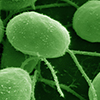 Supervisor: Dr. David Smith
Supervisor: Dr. David SmithVolvocines are a fascinating group of algae, which includes the model organism Chlamydomonas reinhardtii. The mitochondrial genome of C. reinhardtii is an intriguing 16 kb linear molecule with few protein-coding genes, overhanging telomeres, and a free-standing ORF that codes for a protein that is similar to reverse transcriptase (the rtl gene). The function of rtl is unclear, however, replication of the linear mtgenome is thought to be one of its functions. My research focuses on the diversity of rtl within the Volvocales group as well as the relationship between rtl and mtgenome conformation (i.e., circular vs. linear). My key dataset includes newly assembled transcriptomes from 55 diverse species/strains of volvocalean algae. They were assessed using a BLAST-based approach. Each transcriptome was converted into a custom BLAST database and was queried using known rtl sequences using nucleotide-to-nucleotide (blastn) and amino-acid-to-amino-acid (tblastx) searches. Extracted rtl sequences were used for furthermore analysis.
January 13, 2023
Emma Churchman: What makes a good dad? Linking the effect of perceived paternity on sunfish behaviour and hormones
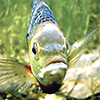 Supervisor: Dr. Bryan Neff
Supervisor: Dr. Bryan NeffParental care is critical for the survival of many young animals. However, parental care is costly to the individual providing care. To balance this cost, parents will allocate their care to offspring they deem valuable, which is often dependent on if the offspring being related to them. Bluegill (Lepomis macrochirus) are a fish species characterized by uniparental care and high levels of cuckoldry. While this species has been shown to adaptively adjust their care in response to paternity level, the mechanisms for this adjustment are not well understood. Hormones like 11-ketotestosterone and prolactin are associated with parental care behaviours, and have been linked to parental care in many species, including bluegill. In my research, I test the theory that these hormones mediate the adjustment in care provided by bluegill parental males by providing indirect visual cues of nest intrusion or direct paternity manipulation.
December 9, 2022
Eric Grimm: Environmental Controls on Mercury Methylation in the English-Wabigoon River System
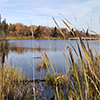 Supervisor: Dr. Brian Branfireun
Supervisor: Dr. Brian BranfireunMethylmercury is a potent neurotoxin which biomagnifies up trophic levels, and is readily formed in aquatic environments under certain biogeochemical conditions. Understanding the environmental controls on methylmercury formation is critical to preventing possible harm. The English - Wabigoon River system has been historically polluted with mercury from a point source discharge within the city of Dryden in Northwestern Ontario. While discharges of mercury have ceased, sediment and fish concentrations remain among the highest in the province. This study will utilize in-situ monitoring of floodplain wetlands to determine if these areas function as ‘hot spots’ of mercury methylation. Further to the field study, laboratory work will examine whether the discharge from the still-operating mill site which previously discharged mercury is still influencing mercury methylation. We will use columns to expose contaminated sediments from the river to the current effluent of the mill to determine if this stimulates mercury methylation.
Samuel Rycroft:Freezing tolerance of herbaceous legumes in the northern temperate zone: evidence for a disproportionate freezing sensitivity?
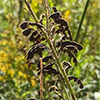 Supervisor: Dr. Hugh Henry
Supervisor: Dr. Hugh HenryIn northern temperate regions, the effects of freezing stress from late fall into early spring can vary substantially among herbaceous (i.e., non-woody) plant species. Anecdotal evidence suggests herbaceous legumes (family: Fabaceae) are more freeze-sensitive than other herbaceous functional groups. As legumes can increase soil nitrogen inputs through symbioses with rhizobia, this may have important implications for ecosystem nitrogen cycling in a changing climate. Though previous investigations have studied the effects of freezing on specific legume species, comparative studies on a variety of leguminous vs. non-leguminous species have been lacking. I have been using a combination of controlled environment (freezing treatments within controlled chambers) and field experiments (increased freezing via snow removal) to investigate the impacts of freezing stress on herbaceous legumes relative to other herbaceous species. Thus far, significant impacts on percent cover, abundance, and biomass have been shown for some of the legumes studied.
December 2, 2022
Anna Chernyshova: The brain-gut axis of honey bees: testing how microbiota affect individual and collective behavior
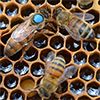 Supervisor: Dr. Graham Thompson
Supervisor: Dr. Graham ThompsonThe holobiont theory of evolution depicts individuals as deeply symbiotic with its gut microbes, which influence host behaviour via signalling from the gut to the brain. This gut-brain axis takes on added complexity for social taxa since individual behaviour scales-up to affect entire colonies. I use the Western honey bee to study how gut microbiota composition of individuals influences collective behaviour. Specifically, I measure how antibiotic depletion or probiotic enrichment of worker gut fauna affect a bee's defensive and foraging behaviours. I have so far observed changes in defensive colony-wide behaviour but need to test if these changes are due specifically to gut microbes and their brain-influencing metabolites. I am therefore validating my field trials via 16S rRNA bacterial gene amplicon sequencing and histochemical staining of individual bee brains. My findings advance the brain-gut axis framework from its current focus on individuals into the realm of higher-order social interactions.
Jackson Kusack: Assignment of harvested waterfowl using stable isotopes
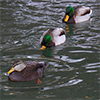 Supervisor: Dr. Keith Hobson
Supervisor: Dr. Keith HobsonTo avoid overexploitation of waterfowl populations, harvest strategies must incorporate accurate information on connectivity between breeding and harvest areas, which necessitates efficient assignment of origin for harvested individuals. Current estimates of breeding metrics rely on wing samples and band returns which are assumed to be representative of a continuous breeding population, but this is unlikely accurate for some species. Stable hydrogen isotopes (δ2H) are naturally occurring intrinsic markers that can be used to infer geographic origin on a continental scale without the need for initial marking. The objective of my thesis was to utilize stable isotopes within feathers to determine probabilistic origin of harvested waterfowl and evaluate current knowledge on connectivity. Specifically, my objectives were to (1) evaluate current calibration relationships for waterfowl, (2) compare harvest derivations using band-return data and stable isotopes, and (3) test the flyover hypothesis in a species of conservation concern, the American Black Duck. Results from this integrative approach will be useful to evaluate and improve conservation efforts for waterfowl populations.
November 25, 2022
Bruce Malloch: Exploring a possible mutualism between crust fungi and microarthropods in Canada's Atlantic perhumid forest
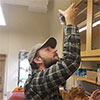 Supervisor: Dr. Greg Thorn
Supervisor: Dr. Greg ThornSoil systems contain vast repositories of the earth’s biodiversity, but many of the interactions that occur between soil organisms remain understudied. This study aims to resolve relationships between soil arthropods and crust fungi, which may represent a mutualistic system where fungi utilize arthropods for spore dispersal in exchange for nutrition. Through network theory, arthropod visitation patterns to fungal fruiting bodies can be used to determine if the system is primarily structured by mutualistic interactions or antagonistic ones. Morphological trait data will be used to supplement interaction patterns by determining if certain species interactions are promoted or limited by compatible trait matches. Finally, metabarcoding of arthropod gut contents will help resolve long standing questions surrounding dietary specialization in hyperdiverse lineages of soil fauna such as the mites. Overall, this study will provide an in-depth first look into the interactions between two highly biodiverse groups of soil organisms.
Paul Wan: Changes in the microbiome during ginseng cultivation
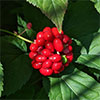 Supervisor: Dr. Vera Tai
Supervisor: Dr. Vera TaiAmerican ginseng, Panax quinquefolius, is a root-crop used for traditional medicine in Asia. The cultivation of ginseng is inhibited by ginseng replant disease (GRD), a condition that decreases ginseng crop health and yield when planted in a former ginseng garden. Fungal and oomycete pathogens are problematic, however the role of the soil bacterial microbiome in causing GRD is not fully understood. Using metabarcoding, I investigated changes to the soil microbiome over three years of ginseng growth to better understand which members of the bacterial microbial community might contribute to GRD. My findings show that microbial communities differed between ginseng gardens, but more importantly that growing ginseng caused a shift in the soil microbiome compared to control sites. Moreover, the microbial communities changed consistently over the three years of ginseng growth. By identifying the specific microbes that contribute to this consistent change, diagnostic tools can be created to assess soil health by Ontario ginseng farmers.
November 18, 2022
Alica Banwell: At the root of it: The introduction of nursery seedlings and their fungi to conifer forests
 Supervisor: Dr. Greg Thorn
Supervisor: Dr. Greg ThornEctomycorrhizal (ECM) fungi are commonly found on tree roots in natural forest stands and are of importance in Canada for their role in supporting boreal tree species and for their production of edible mushrooms such as chanterelles (Cantharellus). In addition to being found on trees in natural forest stands, ECM fungi are also found on tree seedlings growing in nurseries for the purpose of reforestation. Little is known about the effect that ECM fungi established on nursery seedlings have on natural forest stand ECM fungi once the seedlings are planted. My project will investigate whether nursery established ECM fungi continue to persist on seedlings once planted in forests, or if existing ECM fungi in forests form associations with seedlings. This knowledge can be used to inform current reforestation practices in Canada and potentially lead to research to improve these practices by protecting existing, ecologically important ECM fungi in our forests.
November 11, 2022
Holly Deighton: Drivers of soil carbon dynamics in the boreal forest along a soil textural gradient
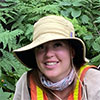 Supervisor: Dr. Zoe Lindo
Supervisor: Dr. Zoe LindoThe boreal forest has historically been regarded as one of the largest terrestrial carbon (C) sinks. However, increased soil organic matter decomposition (SOM) by microbes due to climate change and silviculture (e.g., harvesting and site preparation) may shift boreal forests from being C sinks to C sources. This research seeks to understand the drivers of SOM decomposition, formation, and stabilization in managed boreal forests, specifically looking at both abiotic and biotic processes that regulate microbial carbon use efficiency (CUE). I will use an established stand-scale, full-replicated, experimental study to identify how silviculture influences C dynamics at three boreal forest sites varying in soil texture in Ontario, Canada. I will use an extensive database of forest floor and mineral soils data to determine how silviculture influences soil C stocks and C storage potential. I will also examine how C is utilized by microbes by sampling mineral soils 20 years post-silviculture treatment. Under controlled conditions, I will identify how microbial CUE changes with various warming scenarios. This research will improve microbial-biogeochemical models by providing accurate estimates of CUE to predict how soil texture and silviculture impact microbial activities such as SOM decomposition and, ultimately, the stabilization of C in the boreal forest.
Winter 2022
April 1, 2022
Shyanika Durayalage: Genome-wide investigation of rtl gene and its function in the mitochondrial genome of Volvocales
Volvocines are an interesting group of algae including the model organism Chlamydomonas reinhardtii. The mitochondrial genome of C. reinhardtii is fascinating, being a 16 kb linear molecule with few protein-coding genes, telomeres with overhangs and a free-standing ORF, encoding a reverse transcriptase-like protein (the rtl gene). The purpose of the rtl is unclear, but it is believed to be involved in mtgenome replication. I aim to investigate diversity of rtl across the Volvocales group and also the relationship between the rtl and the mtgenome conformation. A tblastx will be performed on assembled contigs of 55 strains of algae to determine the distribution of rtl using the custom databases created for each taxa. rtl genes will be retrieved and deduced amino acid sequences will be used to determine whether they are functional. Several other mining steps will be done to find out if they have the same architecture as C. reinharditii.
Simone Miklosi: Evaluating the ability of nuclear environmental DNA (eDNA) to determine number of individuals and biomass of Atlantic salmon
Environmental DNA (eDNA) is an emerging population assessment tool with considerable potential for fishes. Current eDNA approaches largely focus on mitochondrial genes, which are used to determine the presence or absence of a species of a fish in a particular habitat. Nuclear genes, in particular microsatellites, have the potential to provide increased population-level information about fishes. Microsatellites are commonly used in population genetics because they typically have considerable standing genetic variation. Despite the potential use of microsatellites for eDNA, the reliability and consistency of the microsatellite genetic information obtained from water samples remains uncertain. Therefore, in my thesis I investigated the ability of microsatellite primer pairs to successfully recover microsatellite alleles from water samples. In my research, I collected eDNA water samples from experimental tanks and river systems, containing Atlantic salmon, to determine if microsatellite alleles could be consistently recovered under different circumstances.
March 25, 2022
Christian Buchanan-Fraser: Post-breeding survival of adult and first-year Bank Swallows in the Great Lakes ecoregion: a radio telemetry study
The post-breeding period poses significant threats to newly fledged birds due to predation, starvation, exposure to inclement weather, and collision risk prior to their first southward migration. To address the gap in knowledge about this period for Bank Swallows (Riparia riparia), I aim to estimate and compare the survival rates of adults and first-years in the Great Lakes ecoregion. In 2018 and 2021, individuals were captured, and radio tagged. Detection data was obtained from the Motus Wildlife Tracking System. Detection data was used to generate movement paths and encounter histories for the estimation of post-breeding survival rates in mark-recapture models. Mark-recapture models will be created and compared in RMark. Comparisons between Bank Swallow age and habitat (lakeshore colony or aggregate pit colony) will be implemented in the models. Results will help determine if Ontario Bank Swallows have age dependent post-breeding survival and if post-breeding survival depends on habitat quality.
Lauren Witterick: The enduring effects of fear on the brain and behaviour in wildlife
Predators affect prey populations not only through direct killing, but also through perceived predation risk – the fear of predators. Responding to predation risk is critical for prey survival, however trade-offs from prolonged anti-predator behaviour can have enduring effects ranging from individual changes in neurobiology up to population and community level effects. To experimentally test the enduring effects of predator fear on the brain and behaviour I manipulated perceived predation risk using auditory playbacks of predators or non-predators in wildlife, starting with acoustic isolation in the lab, progressing to semi-natural conditions and then moving to free-living wildlife. I quantify the effects of fear on neural activation and neurogenesis, while corroborating these effects through behavioural assays. My research integrates biomedical research studying the enduring effects of fear on the brain with fear-induced behavioural changes documented by ecologists in the field, to understand the mechanisms leading the population and community level fear response.
March 18, 2022
Benjamin Souriol: Short-term vs long-term effects of nitrogen addition and warming on ecosystem nitrogen dynamics in a grass-dominated old-field
Increased atmospheric nitrogen deposition and climate warming are two elements of global change likely to have significant impacts on plant and soil processes in temperate ecosystems in the coming decades. Nitrogen is the key limiting nutrient for plant growth in temperate ecosystems. In long-term global change experiments, while cumulative treatment effects on soil nitrogen dynamics can emerge over time, comparisons between short and long-term responses can potentially be confounded with interannual variability in the environment. I will be examining new nitrogen addition and warming plots added to a pre-existing field experiment to compare short-term (3 year) versus longer-term (16 year) treatment effects on net nitrogen mineralization, nitrogen leaching, and nitrogen retention, while controlling for the effects of interannual environmental variability. My research will be beneficial for determining to what extent results from short-term experiments on soil nitrogen responses can be extrapolated to the longer-term.
March 11, 2022
Mehra Balsara: >The effect of artificial selection on coat colour and horn characteristics in thinhorn sheep (Ovis dalli)
Selective harvesting through trophy hunting can have serious consequences for the maintenance of genetically healthy populations. Often this hunting results in a reduction in the size of secondary sexual characteristics (i.e. horns, antlers, tusks). To better understand the artificial selection pressures associated with trophy hunting, I will calculate the predicted evolutionary response to selection for three phenotypic traits (horn growth, horn morphology and coat colour) in a popular trophy hunted ungulate, thinhorn sheep (Ovis dalli). I will then define how the selection pressures acting on each of these traits influence the genetic structure of this species. To address these objectives, I will create a custom SNP array that will be used to genotype individuals, calculate heritability and assess trait and gene associations. This research will help identify the impact of harvesting selection on trait variation and determine how harvesting can be more sustainable to ensure the conservation of thinhorn sheep.
March 4, 2022
Shayla Kroeze: Using conservation genetics to inform the reintroduction of the endangered Mottled Duskywing (Erynnis martialis)
Habitat loss and climate change have caused declines in species diversity and abundance across the globe, including in butterflies which are important components of many ecosystems. Reintroductions are increasingly used to reverse loss of diversity but are most effective when informed using genetic data. I developed 24 microsatellite markers and characterized genetic structure and diversity of the endangered Mottled Duskywing (Erynnis martialis) in Ontario and nearby locations. These were used to inform planned reintroductions in Ontario. I found that populations had moderate levels of genetic diversity and were differentiated from each other. My work forms part of a larger effort to achieve the overall recovery goal of the species in Ontario and will support a locally sourced model for insect species at risk recovery planning. Tools developed in my research may be used to inform future reintroductions of the species, and to monitor success and status of the introduced populations.
Patricia Rokitnicki: Differences in Wing Morphology and Flight Behaviours in Black-throated Blue Warblers
Songbirds vary in physiological, morphological, and behavioral traits depending on their age and sex. This study focuses on how differences in sex and age class can affect wing shape and flight speed in Black-throated Blue Warblers. Birds were caught at Long Point Bird Observatory during their 2021 spring migration. These birds were aged and sexed based on plumage and photographed to assess differences in wing morphology. Birds were tagged with radio transmitters that emitted a signal detected by Motus towers throughout North America. The presentation will focus on how the data collected with radio telemetry in 2014, 2015, and 2021 was used to calculate flight speeds through inter-tower detections. Further investigation into how differences in wing morphology could influence estimated flight speeds for the Black-throated Blue Warblers will also be examined. Tracking songbirds throughout their migration at an increased spatial and temporal scale will improve our understanding of migratory movement.
February 18, 2022
Spencer Heuchan: Nitrogen transfer from cover crops in a changing climate
Effective nitrogen (N) fertilizer management is crucial for the reduction of environmental pollutants associated with agricultural systems. Cover crops, which are used to provide ground cover after the harvest of the grain crop, can potentially improve the sustainability of agroecosystems by reducing nutrient losses. However, the overall success of cover crops in reducing N losses and benefiting the yield of the subsequent grain crop is contingent on the release of N from decomposing cover crop residues being well-synchronized with the grain crop’s N demand. The efficiency of this N transfer may be influenced by variation in winter temperatures, which can affect the survival of cover crops and the timing of the decomposition of their residues. I have used 15N isotopic tracer in field experiments to examine how cover crops alter the dynamics of N losses vs. N transfer to the grain crop in response to climate variability over the winter.
Kiana Lee: Evaluating the effects of warming on floral traits in cucumber
Pollination is an essential ecosystem service that is necessary for the reproduction of flowering plants. However, anthropogenic climate warming has the potential to change plant-pollinator interactions by affecting floral traits that are essential for pollination. My objective is to investigate how floral traits that are important for pollinator visitation change when plants are grown at ambient or +4°C temperatures. To address this, I will quantify the size and shape of UV floral guides (signals to pollinators that are only visible under UV wavelengths of light) using UV-visible photography. Additionally, I will evaluate changes in human- and UV-visible flower pigmentation using GC-MS. Finally, I will correlate changes in key floral traits with flower development and plant growth. From this research I will be able to determine how warming could alter how foraging pollinators receive visual cues and thus provide pollination services.
February 11, 2022
Corrine Génier: The role of aquatically derived lipids in determining fatty acid composition of aerial insectivorous bird
Aerial insectivorous songbirds, which feed on insects while flying, have been declining for decades. A contributing factor could be the decline in the quality of insect prey. Fatty acids, the building blocks of fat, are known to be important for the health and growth of young birds and insects emerging from waterbodies supply more beneficial fatty acids (eg. omega-3) than terrestrial insects. Thus, diet quality is expected to vary across habitats and among species with differential access to aquatic insects. Yet, songbirds can make certain fatty acids to an extent. The ability to synthesize beneficial fatty acids may be vital if birds do not have access to aquatic insects. My thesis will compare the diet composition of different bird species nesting near waterbodies and further inland. I will also conduct experiments in captivity and in the wild to understand how fatty acids are converted inside the body of birds.
February 4, 2022
Trevor Pettit: Soil foodweb carbon cycling under warming
In North America, future soil temperature and moisture conditions under climate change may be more extreme and more variable than originally thought. Extreme heat events affect both the predator and prey species that comprise soil communities, but this effect may differ in magnitude between predator and prey communities, also altering carbon flux. However, little is known about what effects these changes in soil community composition have on larger ecosystem functioning, like carbon sequestration. Thus, the objective of my proposed research is to quantify and model the effects of experimentally-imposed temperature and moisture conditions that simulate potential future climate disturbances, on peatland soil food web flux and soil carbon sequestration.
Jessica Deakin: Links between migration timing, wing morphology, and the environment
Migratory birds are under pressure to synchronize their arrival timing at the breeding grounds with phenology. Males are under additional pressure to arrive early (“protandry”) presumably to reduce intraspecific competition for access to breeding sites and mates. A primary mechanism underlying protandry is departure timing. Individuals use environment cues such as weather and food supply to time their departure. They may also use social cues; however, this has not been empirically tested. For my Ph.D., I experimentally modify the social environment of a songbird to investigate whether increased male-male competition accelerates migration timing. Another mechanism of protandry is migration speed. To test the relationship between wing shape sexual dimorphism and flight performance, I conducted a multi-season field study using a custom designed flight chamber equipped with qual-level infrared technology. I also modelled the relationship between wing length sexual dimorphism, phenology, and arrival timing using a long-term bird banding dataset.
January 28, 2022
Campbell McKay: Do some species of milkweed better prepare monarch butterflies for migration?
Declines in the monarch butterfly (Danaus plexippus) population have been linked to declines in its larval host plant, milkweed (Asclepias spp.). While common milkweed (Asclepias syriaca) is generally considered the larval food of the monarch butterfly, and has been the subject of much study, monarch larvae live on many species within the milkweed genus Asclepias. Studies to date have examined the survivorship of larvae on these other species, and the different herbivore defenses they have, but not how well they prepare monarch butterflies for their fall migration to their overwintering site in Mexico. To study this, I will rear monarch butterfly caterpillars in both early and late summer on three different species of milkweed: Common milkweed, swamp milkweed (Asclepias incarnata), and butterfly milkweed (Asclepias tuberosa). Once they have reached adulthood, I will use their body weight, lipid mass, and wing morphology as indicators of their capability to migrate.
Scout Thompson: Selection and non-random mating at class I of the major histocompatibility complex (MHCI) in Melospiza melodia (song sparrows)
Evolutionary history is characterized by an endless arms race between pathogens and host immune systems. An important player in immune defense is the major histocompatibility complex (MHC), referring to a large family of genes responsible for pathogen detection. Given its important role, the MHC has been heavily subjected to selection - often reinforced by mate choice. While numerous studies have examined the evolutionary mechanisms of MHC class II (responsible for extracellular detection) not much care has been given to class I (responsible for intracellular detection). My research seeks to investigate these neglected loci to see if they will reveal similar findings, or if I will discover something completely different. Through the usage of genetic information, and long hours spent spying on birds, I plan to uncover which mode of selection has historically occurred at the MHCI of song sparrows, and whether genotype plays a significant role in their mate selection.
January 21, 2022
Timothy Hain: Musings on 40 years of Bluegill research (with some of those years featuring me)
January 14, 2022
Ala Abdel Rahman: The interaction of cover crops and entomopathogenic fungi to manage wireworm pest populations
Wireworms, the larval stage of click beetles (Coleoptera; Elateridae), are a significant pest of vegetable crops worldwide. Wireworms have caused considerable damage to corn, wheat, and potato crops in North America, Europe, and Asia. According to recent research, certain cover crops can reduce wireworm populations by using natural compounds released by the growing plant (allelopathy) or after being mulched into the soil (fumigants). I will investigate whether buckwheat, brown mustard, and sorghum-Sudan grass, combined with two different strains of Metarhizium brunneum, an entomopathogenic fungus, could be applied as a strategy to reduce wireworm populations in southwestern Ontario potato fields. This study will also focus on the potential interaction between these allelopathic cover crops and Metarhizium brunneum.
Rachel Rajsp: Investigating the soil microbiome of North American ginseng (Panax quinquefolius)
Ginseng replant disease (GRD) is of high significance to the Ontario ginseng industry as it can cause the complete loss of ginseng crops. Replant disease occurs when a new ginseng crop is planted in a field where ginseng was grown previously. The prevalence of GRD has since limited the amount of land in North America that is available to grow ginseng. Several pathogens that have been discovered to cause rot include: Neonectria, Ilyonectria, Phytophthora and Pythium. This project will investigate new primers that permit identification of individual species of certain target fungi. Using new and pre-existing primers, I will compare the fungal and oomycete communities present in ginseng replant soil (collected in 2022) and the first and fourth years of a new healthy ginseng crop (collected in 2018 and 2022). Next-generation sequencing (NGS) will be used to identify what species are present in the soil for each garden site.
Fall 2021
December 3, 2021
Tyler Watson: Investigating mycelial-crop residue mat application to reduce early-colonizing weeds in row-crop agriculture
Herbicide use within conventional agriculture has contributed to greatly increased crop yields since its widespread adoption, however environmental concerns regarding overuse and reliance on selective herbicides continue to mount. Using five fungal species and two crop residues in a factorial design, I created a novel slurry to control weeds through inhibition by the mycelial mat formed after application to soil. I monitored weed stem counts and the strength of the mycelial mat under the treatments. Additionally, as a proxy for crop yield, I measured the wet and dry weight of crop plant grown under application treatments. Weed prevalence was significantly reduced when compared to a bare soil control, but not when compared to a substrate only control without fungal inoculum. Similar strength values were recorded between treatments and control, suggesting poor colonization of the substrate under greenhouse or field conditions. No significant weed reduction was achieved in field trials.
Erica Stroud: Short-term vs. long-term responses of soil carbon and microbial activity to warming and nitrogen addition in a temperate old field
Climate warming and atmospheric nitrogen deposition are two global change drivers expected to exert strong effects on northern temperate ecosystems over the next century. I added new nitrogen addition and warming plots to a pre-existing nitrogen addition and warming field experiment in London, Ontario to compare the short-term (1-2 year; new plots) versus long-term (14-15 year; old plots) treatment effects on soil carbon and microbial activity. I used soil density fractionation and size fractionation to separate soil carbon fractions and analyzed carbon quality using FTIR. I used extracellular enzyme assays to assess microbial responses. The soil organic matter free light fraction increased in response to nitrogen addition in the old plots but decreased in the new plots. Interactions between warming and plot age were significant for some hydrolase enzymes. These results confirm short-term responses of soil carbon and microbial activity differed from long-term responses in this global change field experiment.
November 26, 2021
Dariusz Wojtaszek: Applying stable isotope techniques to evaluate origins of northern pintails (Anas acuta) harvested in Canada
The Northern Pintail (Anas acuta) is a waterfowl with population levels consistently below long-term management goals. Conversion of native habitat agriculture limits recruitment and population growth. My objective is to provide a proof-of-concept of how stable isotope ratios can complement existing pintail management. I used hydrogen isotope ratios (δ2H) in feathers to determine that the most likely origins of harvested pintails are in the northern boreal region of Canada, despite long-term population estimates attributing most of the pintail population being supported by the Canadian prairies. I used carbon and nitrogen stable isotope ratios (δ13C, δ15N) to differentiate individuals originating in boreal biomes, rather than agricultural-influenced prairie habitats. These findings can be used by wildlife managers to inform adaptive harvest management protocols and population models of pintails.
Noor Saeed Cheema: Manipulating the root mycobiome of corn (Zea mays) to enhance plant performance and reduce pathogen pressure
Manipulating the root mycobiome of crops could potentially increase yield by reducing pathogen pressure and improving access to soil water and nutrients. However, identifying organisms that can induce these effects remains a challenge. My objective is to investigate how selected fungal isolates affect plant performance and the root mycobiome when applied to soil in which corn seedlings are grown under growth room conditions. In previous studies, A&L Biologicals observed major productivity differences within fields of corn, soybean, and wheat rotations. Root-associated fungi from corn were identified and isolated in culture. Comparing the fungal communities in high- versus low-yielding sites may help identify key fungal isolates that could improve crop productivity. Corn seeds were sown into soil from low-yielding sites inoculated with potentially beneficial fungal strains, with or without a co-inoculated soilborne fungal pathogen of corn, to quantify if different inoculation regiments affect crop health, productivity, and the soil mycobiome.
November 19, 2021
Matt Meehan: From individuals to communities: The effect of climate change on ectothermic predators
In my PhD, I used feeding and mesocosm experiments to examine how climate change affects ectothermic predators at the individual-, population-, and community-level, using mesostigmatid mites (Arachnida: Parasitiformes) as my model predator. With feeding experiments, I showed that predator mites increasingly fed on small-bodied but not large-bodied prey under warming, which lowered their energy intake. I hypothesize predators lowered their handling costs associated with smaller prey, rather than maximize energy gain by feeding on larger prey to offset higher metabolic demands. Furthermore, with predator mite and collembolan prey populations, I found that greater exposure of predators (and prey) to warmer temperatures increased the average size of their prey and strengthened predator-prey interactions, suggesting predators increasingly fed on smaller prey. Finally, I observed that short-term intensive warming shifted soil Mesostigmata assemblages, which was primarily due to the increased abundance of a single asexual species, Veigaia mitis.
Katarina Kukolj: Investigating the effects of the Blewit Mushroom Lepista nuda on the community composition of its soil environment
This study will investigate the effects of the edible Blewit mushroom (Lepista nuda) on the community composition of its soil environment in coastal regions of Newfoundland, Canada. Previous studies on Blewits have discovered antimicrobial properties in the lab, but there have been no field studies to observe how the soil and the organisms in it could change by growth of Blewit mycelium in their natural environments. Therefore, this study includes sampling soil at various time points from known natural Blewit patches and nearby treatment plots inoculated with Blewit mycelium. Arthropod, nematode, bacterial and fungal members of the soil community will be identified, and their relative abundance determined by DNA metabarcoding analyses. These results will tell us if potential crop pests and plant pathogens are significantly reduced by the growth of Blewit mycelium, which could lead to use of Blewits as an environmentally friendly biopesticide and potential co-crop.
November 12, 2021
Simone Miklosi: Evaluating the ability of nuclear environmental DNA (eDNA) to determine number of individuals and biomass of Atlantic salmon
Environmental DNA (eDNA) is an emerging population assessment tool with considerable potential for fishes. Current eDNA approaches largely focus on mitochondrial genes, which are used to determine the presence or absence of a species of a fish in a particular habitat. Nuclear genes, and microsatellites in particular, have the potential to provide increased population-level information about abundance. Microsatellites are commonly used in population genetics because they typically have considerable standing genetic variation. Despite the potential use of microsatellites for eDNA, the reliability and consistency of the microsatellite genetic information obtained from water samples remains uncertain. My research will capture and extract eDNA from water samples collected from tanks and streams containing differing numbers of Atlantic salmon to compare the microsatellite genotypes inferred from the water samples to those of the individuals. Preliminary work has established four working microsatellite primer pairs and the successful recovery of microsatellite alleles from water samples.
Alicia Banwell: At the root of it: The introduction of nursery seedlings and their fungi into conifer forests
Ectomycorrhizae (ECM), a type of association between fungi and plants, are of importance in Canada for their role in supporting boreal tree species and are of interest for their production of valuable edible mushrooms such as chanterelles (Cantharellus). ECMs are present in a wide range of habitats, including natural forest stands, forest stands that have experienced severe disturbances, and seedlings reared in nurseries for reforestation efforts. Little is known about the effect that nursery established ECMs have on forest environments once seedlings are planted. My project will investigate whether ECMs established on nursery seedlings continue to persist once planted in forests, or if existing ECMs in forests, such as Cantharellus, form associations with seedlings. This knowledge can be used to improve reforestation practices by protecting existing valuable ECMs in forests, or to provide the forestry industry with the ability to form associations of valuable mushrooms, such as Cantharellus, on seedlings.
Winter 2021
April 23, 2021
Andrew Pitek: Potential for probiotics to mitigate environmental stress in Western honey bees
The human microbiome initiative recognizes the positive role that probiotics can play in reducing dietary stress and promoting overall health in the face of disease. My research draws a parallel from this initiative to the plight of honey bees that, in Ontario, can face nutritional or pathogenic stress within the context of the province's agri-food complex. I will present initial findings from a multi-apiary field study that tested the role of probiotics and delivery methods on bee health across three distinct habitat types. First, both oral and topical delivery of Lactobacillus plantarum, L. rhamnosus and L. kunkeei in the form of an edible patty or an aerosol mist appear to be practical solutions that could be adopted by beekeepers. Second, though my in-lab analysis remains underway, it appears that the oral treatment in particular is associated with low Varroa load, especially in urban habitats where colonies are most likely to be food-limited. I am currently using PCR amplification of pathogen-specific DNA markers to test for differences in American or European foulbrood load between treatments and habitats. My goal is to test the efficacy of probiotic formulation and simultaneously develop new tools for probiotic delivery in the field.
Marianna Wallace: Root-inhabiting and rhizosphere mycobiomes and crop yield
The rhizosphere, which comprises of the soil that is in direct contact with the roots of a plant, is a hot spot of microbial diversity and dynamic interactions. The rhizosphere has elevated numbers of active microorganisms including plant-beneficial organisms and plant pathogens. The interactions that occur in the rhizosphere can be mutualistic and beneficial to plant growth, with surrounding fungi improving nutrient acquisition and stress tolerance. However, in the rhizosphere are also fungal pathogens that elicit harmful effects on plants, which can result in crop losses. I aim to profile the root and rhizosphere mycobiomes of low and high yield patches of wheat and corn planted in rotation on the same fields by next-generation sequencing of the ITS region. I hope to identify microorganisms providing protective or pathogenic effects for these crops and assess potential correlations between soil and plant health metrics and fungal communities. The knowledge gained through this research can be integrated into current soil health management systems to reduce crop losses.
April 16, 2021
Carlos Barreto : Diversity and drivers of oribatid mites (Acari: Oribatida) in boreal peatlands
Boreal peatlands are important ecosystems for carbon cycling, storing 1/3 of the world’s terrestrial carbon in only ~3% of the globe, making them a key mitigation strategy in global climate warming. Experimental warming has shown to affect plant and microbial communities in ways that potentially shift peatlands from carbon sinks to sources. The soil food webs including the microarthropod community are key in carbon cycling, but are relatively understudied in both peatlands and under experimental warming. My research capitalized on a large-scale experimental warming manipulation in two peatland sites in Northern Ontario, and addresses: 1) factors that drive litter decomposition and oribatid mite communities by examining different microhabitats 2) how these communities shift under experimental warming, and 3) the diversity of oribatid mites in Canadian peatlands. I show that peatland oribatid mite communities are driven by soil moisture and temperature, and that responses to warming are species- and site- specific. My synthesis of oribatids in Canadian peatlands updates the records from 71 to 186 species. My research also discusses the role of peatland microarthropods and their relation to ecosystem processes under environmental changes, as it is the first to link changes in soil biodiversity to peatland carbon storage and release.
Claire Bottini: Post-breeding survival of adult and first-year bank swallows in the Great Lake ecoregion
Organisms regularly adjust their physiology to respond to predictable seasonal or environmental variation. Annual cycle transitions could be disrupted by contaminants (e.g., methylmercury) or stressors (e.g., inclement weather, food unpredictability). However, the potential combined impact of stressors and methylmercury exposure on avian physiology and seasonal transitions has rarely been studied. To evaluate the impact of methylmercury exposure on songbirds’ physiology and seasonal transitions I worked with song sparrows (Melospiza melodia). Birds were exposed to environmentally relevant doses of methylmercury in combination, or not, with unpredictable food stress and I observed their physiological changes throughout two seasonal transitions: summer to fall and winter to spring. My main finding is that methylmercury delayed moult completion, and increased migratory behaviour in fall. Such effect on migratory behaviour could be due to an increase in corticosterone hormone levels in methylmercury exposed birds. In contrast, the preliminary results of the winter-spring seasonal transition show no treatment effects on brain GnRH producing cells number, blood testosterone levels or testis mass, indicating that spring reproductive onset might not be affected by methylmercury in birds. Overall, my research also highlights the importance of studying contaminant effects over multiple seasons when assessing risk for wildlife.
April 9, 2021
Colleen Wardlaw: Microplastics in white sucker (Catostomus commersonii) and common carp (Cyprinus carpio) from the Upper Thames River, Ontario, Canada
Microplastics have been found throughout aquatic environments and have been reported to impact a number of species. Rivers have been identified to act both as depositional sinks and transport pathways of microplastics to lakes and oceans, however few studies have been conducted in tributaries of the Laurentian Great Lakes system. In addition, limited data are available regarding microplastic ingestion in both riverine and demersal groupings of fish. This study therefore investigated a potential connection between microplastic levels in benthic sediment and ingestion by riverine demersal fish. Building on a previous study of microplastics in benthic sediment from the Thames River, Ontario, demersal fish white sucker along with opportunistic capture of common carp were collected from 11 locations in the Upper Thames River. The gastrointestinal tracts of fishes were digested using 20% KOH and filtered after 48 hours. Microplastics were manually characterized by shape, colour and size, and a subset was analyzed using Fourier Transform Infrared Spectroscopy (FTIR). Results suggest that fishes from urban areas contain a higher number of microplastics, aligning with previous findings regarding urban land use as a contributing source of microplastics to inland waters.
Christian Buchanan-Fraser: Post-breeding survival of adult and first-year bank swallows in the Great Lake ecoregion
The post-breeding period before fall migration remains an understudied period in the life cycle of migratory birds. The post-breeding period poses significant threats to young newly fledged birds through exploring their new habitat, predation, starvation, or otherwise failing to survive until their first southward migration. To address this gap in knowledge for bank swallows, I will determine survival rates of adult and juvenile bank swallow in the Great Lakes ecoregion. Individuals will be captured using mist nets, banded, have morphological measurements taken, and radio tagged affixed. Detection data will be downloaded from the Motus database. Following Evans et al., (2020), detection data will be converted to encounter histories. Encounter histories will be used to differentiate between lakeshore colony bank swallow and aggregate pit colony bank swallow. Mark-recapture models will be created to estimate post-breeding survival. Models will allow for the comparisons of survival between adults and juveniles and between lakeshore colonies and aggregate pits. Results obtained from this project will help determine if Ontario bank swallow have age dependent post-breeding survival curves and if bank swallow post-breeding survival depends on habitat quality.
March 26, 2021
Nikita Frizzelle: A South African mammal community fears the human “super predator”
Humans have been considered “super predators” due to our ability to kill every animal on the planet. In Africa, where prevalent hunting on various large mammals occurs, there is very little experimental literature to document how hunting affects the behaviour of these hunted species. My research objective was to experimentally test whether fear behaviour of a South African mammal community is affected by human presence and hunting. I used a newly developed technology, the Automatic Behavioural Response system, to video record the responses of wildlife to five playback treatments: birdsong, lion snarls, gunshots, dog barks, and human voices. My results show that the majority of the species in the community flee most to the human voice, surpassing their response to both lions and hunting stimuli. However, there was no difference in behaviour between areas of hunting pressure or human presence. These findings demonstrate that not only can humans be more frightening than non-human predators, but also that this fear of us can pervade whole communities of mammals.
March 19, 2021
Michael Bonneville: The evolution of genomic architecture of organelle plasmids
Plasmids are extrachromosomal replicons that do not share homology to their host genome and have been found to be associated with the mitochondria of many plant, protist, and fungal species as well as with chloroplasts in a few instances. They exist as circular or linear molecules and often contain open reading frames for viral-type DNA and RNA polymerases as well as reverse transcriptases. Although studied extensively in model systems from the 1980s to the early 2000s with the hope of finding useful vesicles for the transformation of genetic products, research in this small sub-field of mitochondrial genomics has halted, despite the exponentially increasing number of genome sequences available. The goal of my project is to data-mine sequence data from GenBank for plasmid-derived sequences and perform evolutionary analysis on a large scale. Mined data can be used to make gene trees and find cases of horizontal gene transfer between species. RNA datasets will be used to find evidence of transcription and to detect the evolution of RNA editing. From this, I hope to widen the understanding of the distribution of plasmid sequences and explain why they are upkept in some species but not others.
Jessica Stokes-Rees: The response of soil invertebrate and abiotic factors to cover crops planted as a non-conventional farming practice
Conventional agricultural practices such as deep plowing and the use of chemical fertilizers can reduce both the abundance of beneficial soil invertebrates and their species richness. A declining efficacy of these practices has increased the interest in non-conventional (NC) farming. These includes the use of organic fertilizers, reduced tillage and more extensive rotational cropping, such as the use of cover crops (CCs). Many studies have focused on the benefits of CC-use in relation to crop yield and soil quality. However, very little is known about the responses of beneficial soil fauna to CC use. My study focuses on how different groups of CCs, such as grasses and legumes, influence these soil organisms. It will take place at a NC farm in St. Thomas, ON that practices organic protocols, reduced tillage, and the use of CCs. My research will focus on soil keystone species, such earthworms. Such bioindicators can be used to obtain crucial information regarding changes in the health status of soils in response to CC use.
March 12, 2021
Kevin Park: Characterizing a Genetic Basis of Dispersal and Recolonization in a Butterfly Metapopulation
Persistence of a metapopulation and local populations within it are dependent on the dynamic balance between local extinction and recolonization of habitat patches, in which dispersal, the movement and settlement of individuals from their native patch to another, serves as the key mechanism. Despite its importance, the genetic basis of metapopulation-level dispersal is poorly understood, especially in natural systems. In my study, I will utilize the effects of local extinction and removal events on the genetic structure of local populations to characterise a genetic basis of dispersal and recolonization in Parnassius smintheus, an Apollo butterfly species that inhabit meadow patches in the Rocky Mountains. I will be focusing on a metabolism-related candidate locus - Phosphogluclose isomerase (Pgi), that has been associated with variation in movement abilities across several other insect species. I will genotype and assess the change in frequency of single nucleotide polymorphisms (SNP) within the Pgi locus, as well as other SNPs throughout the P. smintheus genome across historical extinction and removal events. I hypothesize that variation in Pgi underlies variation in dispersal in P. smintheus, and therefore predict that variations associated with increased dispersal ability or likelihood will increase in frequency within the local population following recolonization.
March 5, 2021
Patricia Rokitnicki: Age differences in stopover and flight behaviour of black throated blue warblers
Animals use migration to find food or suitable habitat for breeding and raising their young. Most North American songbirds are nocturnal migrants with a short-hop migration strategy, meaning they use stopover sites to refuel and build up energetic stores before continuing on their journey of several hours of nocturnal flight. Previous studies have shown that juveniles tend to have longer stopovers and less efficient migratory flight behavior. However, little is known about how age differences can impact songbirds' flight speed. This study focuses on how morphological characteristics influenced by age impact a bird's migration speed. My research will be conducted on black-throated blue warblers at Long Point, Ontario. The birds will be measured, photographed, radio-tagged, and released. Data collected by the Motus Wildlife Tracking System will be used to calculate inter-tower flight speed for different age classes and provide illustrations of the birds' post-departure flight paths. Additionally, GLMs will be used to show sex, age, and different capture dates of birds. This study will provide critical information for piecing together complete migratory journeys in songbirds and help researchers better understand how climate change impacts avian species and how their populations will adapt to these changes to persist into the future.
Samuel Rycroft: Freezing tolerance of herbaceous legumes in the northern temperate zone: are legumes disproportionately sensitive to freezing?
Most described legumes (family: Fabaceae) form symbioses with nitrogen-fixing rhizobia. These associations increase soil nitrogen inputs, potentially increasing ecosystem fertility. Stressors which affect legumes can therefore impact ecosystem nitrogen dynamics. One common stressor in northern temperate regions is freezing, which can cause mortality or have sub-lethal effects. Herbaceous (i.e., non-woody) species can benefit from snow cover, as it minimizes freezing exposure over winter. Reductions in snow cover, such as those resulting from increased temperature variability, can thus cause plants to experience more severe and frequent freezing. Prior findings suggest herbaceous legumes may be disproportionately susceptible to freezing relative to other functional groups, but these results were based on a limited number of naturally occurring legume species. Using field experimentation with established populations of herbaceous legumes and transplanted legumes and controlled experiments, I have been examining these trends. I have found some but not all herbaceous legume species studied thus far are disproportionately susceptible relative to their non-legume neighbours. These findings suggest that the high freezing susceptibility of herbaceous legumes in northern temperature regions may be a broader phenomenon and may have important implications for changes in ecosystem nitrogen cycling in response to climate change and increased variability in winter conditions.
February 26, 2021
Pok Man Paul Wan: Changes in the soil microbiome during ginseng cultivation
Ginseng is a root plant from the genus (Panax) that is from the family Araliaceae. This plant is used as a traditional herbal medicine in Chinese and Korean culture due to its many medicinal properties. Numerous clinical studies have shown that the major bioactive compound (ginsenosides) holds health benefits towards the body. More importantly, Canada is one of the world’s largest producers with an annual revenue of up to $240 million. Most of the Canadian-grown ginsengs are from Southwestern Ontario, but farmers are currently facing two major problems. Firstly, ginseng replant disease prevents farmers from being able to replant ginseng after it has been grown into gardens. Secondly, farmers are losing suitable lands to grow ginseng, which places a threat on their business. This study is intended to determine how the change in microbiome after the growth of ginseng in new gardens increases the susceptibility to ginseng replant disease for subsequent plantings. Through the use of 16s ribosomal RNA metabarcoding, I will be examining the soil microbiome composition mainly by determining the alpha and beta diversity within soil samples that are collected seasonally from the gardens. In addition, I will also be investigating which taxa or groups of taxa respond similarly throughout ginseng cultivation with network analysis. This work provides insight into the species diversity that are contributing to ginseng replant disease and can potentially be considered as a diagnosis for ginseng farmers in Ontario.
Jacob Lasci: Evaluating competition and forage niches of Lake Huron salmonids
The predatory fish community in Lake Huron is predominantly composed of four salmonids: lake trout (Salvelinus namaycush), Chinook salmon (Oncorhynchus tshawtscha), rainbow trout (O. mykiss), and Coho salmon (O. kisutch). Since 1980 there has been a decline in the biomass of the prey fishes that these salmonids consume. Importantly, one of the most widely consumed prey fish, alewife (Alosa pseudoharengus), suffered a population crash in 2003, imposing a potentially major nutritional stress on Lake Huron’s salmonids. However, little is known about the response of these salmonids to the decreasing prey abundance. My study will compare the diets of salmonids before and after the 2003 alewife crash using stable isotope analysis of archived scale samples collected prior to 2003 and scale samples collected in 2020. Stable isotope analysis will also be conducted on muscle and liver tissue samples to provide a complete timeline of integrated diet between two and four months prior to fish capture. Stomach content analyses (DNA metabarcoding and visual identification) will be further used to provide detailed information about the current diets of these salmonids. Together these data will help quantify the importance of different prey fishes in Lake Huron and support the management of these salmonids.
February 19, 2021
Marnie Demand: Cadmium uptake in plants as influenced by selenium uptake and sulphate availability
Cadmium-contaminated soils can pose a risk not only to plants but also to consumers. This risk may be reduced by applying selenium, an essential nutrient for animals, which decreases plant cadmium uptake. One possible mechanism of action is through selenium-induced lignification of root cell walls, preventing cadmium from being transported to the shoots. However, where excess sulphate is present, this may not work. Selenium in the form selenate competes with the nutrient sulphate for uptake. Thus, sulphate can interfere with selenate uptake, potentially impacting cadmium uptake. I tested the interactions among cadmium, selenate, and sulphate comparing two species that hyperaccumulate selenium, Astragalus bisulcatus and A. racemosus, and A. canadensis, which takes up much less selenium, along with five crops. Results to date, examining Astragalus spp. found no significant difference in total lignin content of roots in response to selenate. Additionally, increased selenium concentrations were correlated with increased cadmium concentrations across species but trends within species were inconsistent. Additional data on selenium and cadmium concentrations in the crop species is forthcoming. These results will be useful in agronomy, indicating whether selenium biofortification of crops being grown on mildly cadmium-contaminated soil may improve their safety, or if it would be detrimental.
Liam Brown: Investigating the response of soil bacteria to long-term exposure of macrolide antibiotics
Antibiotic resistance is prolific in the environment. Environmental bacteria have developed diverse genetic mechanisms to resist harmful chemicals (antibiotics) produced by their competitors, and for a century, humans have mass-manufactured these antibiotics to treat bacterial infections. The overconsumption and misuse of antibiotics in healthcare and agriculture, however, has led us into an unprecedented crisis characterized by rising multi-drug resistance in pathogenic bacteria. There is a great need to understand the pathways through which antibiotics enter the environment in order to reduce future interactions between resistant bacteria and humans. The use of biosolids (sewage sludge) as agricultural soil fertilizer is one such pathway, as biosolids frequently contain antibiotics that have carried over from the sewage treatment process. To determine if biosolids could promote antibiotic resistance in soil bacteria, we applied a class of antibiotics commonly found in biosolids to experimental soil microplots for ten years. For my MSc thesis project, I sequenced the 16S ribosomal DNA, gene cassettes (mobile genetic elements known to carry antibiotic resistance genes), and the total environmental DNA within these soil microplots to investigate potential differences in the composition and diversity of bacterial communities, mobile genetic elements, and antibiotic resistance genes, respectively.
February 5, 2021
Breanna Craig: Long term vs. transient plant responses to warming and nitrogen addition in a temperate old field
Global climate warming is expected to intensify, particularly at higher latitudes, in the following decades. In addition, for many northern temperate regions, industrial and agricultural activities have increased over the last century, resulting in high rates of atmospheric nitrogen (N) deposition, with important implications for plant productivity, diversity and global carbon cycling. I am expanding on a pre-existing 15-year-old field experiment to compare the short-term (1-2 year) vs. long term (14-15 year) effects of warming (via overhead heaters) and N fertilizer addition on plant productivity, relative species abundances, and plant tissue N content. Previous results revealed both warming and atmospheric N deposition had additive effects on plant productivity. In my first year of observation, spectral data (normalized difference vegetation index) indicated that the timing of plant green-up was accelerated in warmed plots and both short and long-term N plots. At the peak of vegetation growth (mid-summer), both short term and long-term N treatments increased Poa pratensis biomass, and short-term N addition increased total root biomass. Therefore, contrary to my expectation, the long-term effects did not diverge substantially form the long-term effects, which may be due to the continued persistence of the same dominant grasses at the field site.
Shayla Leigh Kroeze: Conservation genetics of the endangered Mottled Duskywing (Erynnis martialis)
Fragmentation, degradation, and loss of suitable habitat paired with climate change have caused declines in species diversity and abundance across the globe, including in butterflies which are important components of many ecosystems. Species re-introduction or translocation is increasingly used as a strategy for restoring biodiversity. Early re-introductions of butterfly species were largely unsuccessful due to a lack of established protocols and insufficient background knowledge. I will develop molecular and genetic tools to inform planned re-introductions an endangered species of butterfly in Ontario, the Mottled Duskywing (Erynnis martialis). My work will form part of a larger, collaborative effort to achieve the overall recovery goal of the species in Ontario and will support a locally-sourced model for insect species at risk recovery planning. Although the Mottled Duskywing is imperiled throughout most of its range, very little published research exists on the species, and no efforts to recover imperiled populations have occurred anywhere in the U.S. or Canada. My work will provide the first information on genetic diversity and structure in this species and will be directly relevant to its conservation and re-introduction in Ontario.
January 29, 2021
Zachary Balzer: Molecular correlates to kinship and invasiveness in urban-dwelling termites
As eusocial insects, termites normally maintain kin-based colonies that are closed off to intruders. Termites invasive to urban areas may, however, abandon their colonial life for more inclusive societies that are indifferent to kinship. These large decentralized 'unicolonies' are difficult to eradicate and might arise from a loss of cue diversity upon invasion that hampers their normal ability to distinguish close from distant kin, or to recognize relatives at all. For my PhD, I will perform a series of studies on the locally invasive termite Reticulitermes flavipes that will test this hypothesis on several fronts. First, I will develop behavioral assays that tease apart environmental from genetic factors associated with loss of recognition in urban populations. My anticipated results may help to explain transitions to unicoloniality that are relevant to the pest control industry in Canada and abroad. Second, I will perform an in-depth statistical analysis of urban geographic and socio-economic correlates to termite infestation in Toronto and other Canadian municipalities. Finally, I will develop a comparative sequence analysis pipeline to reveal genetic diversity on a grand scale and possibly reveal genomic signatures of a social insect invasion.
Zach Anderson: Post-Fledging Dispersal and Island Habitat Use by Migratory Songbirds in Southeastern Georgian Bay
The period between nesting and fall migration, termed post-fledging, is an important and understudied stage for temperate migratory birds. Survival to fall migration for newly fledged independent songbirds becomes more difficult as resources (food and shelter) as well as space are limited. These interactions of resource scarcity and fledgling survival can be observed in habitats where several species are competing for similar finite resources, such as on islands. Georgian Bay, Ontario is a largely untouched area of the Great Lakes ecoregion composed of an abundance of island habitats. These islands provide a unique landscape for breeding and migrating songbirds. Island habitats are separated from the mainland and may impede dispersal between adjacent habitats. The purpose of this research is to understand how avian diversity varies among southeastern Georgian Bay islands in relation to biotic and abiotic factors, and to determine whether movements differ between juvenile and adult songbirds during the postfledging period. Spring breeding bird surveys will be completed on eight (8) islands in southeastern Georgian Bay to identify areas that are actively being used by songbirds. The two (2) islands with the highest songbird breeding density per area will be chosen to capture and attach radio transmitters to focal species individuals. Each island will have 20 juveniles and 20 adult White-throated Sparrows tagged to track their inter and intra island movements. Tagged birds will be tracked using MOTUS towers within and outside of the region as well as daily active tracking methods.
Fall 2020
December 11, 2020
Garth Casbourn: The role of testosterone in regulating the movement behaviours of juvenile migrant songbirds
The post-fledging period is a critical stage in the life of a juvenile migrant songbird. Juveniles must develop their foraging skills, as well as the flight, navigation, and orientation skills that will allow them to make their first migration. Movement across the landscape is critical to developing all of these skills, and there is likely individual variation in the propensity to move. Testosterone is related to individual differences in migration distance in adult sparrows, but it has not been studied in the context of other movement behaviours. I investigated the relationships among movement propensity in a novel environment, juvenile prospecting movements, and testosterone profile in juvenile Song Sparrows (Melospiza melodia). I characterized testosterone profile as the maximal level of circulating testosterone produced in response to an injection of GnRH. I introduced fledged, free-living juvenile birds to an artificial chamber (2.4 x 2.4 x 1.8 m) containing 5 artificial trees, and recorded activity for 10 minutes as an index of exploration behaviour. Finally, I handtracked radiotagged birds for 2-4 weeks to assess prospecting movements. I present my findings on the correlations between these behavioural and physiological phenotypes.
Rebecca Howe: Effects of experimental malaria infection on migration of Yellow-rumped Warblers (Setophaga coronata)
Avian migration between breeding and wintering grounds is an energy intensive behavior that requires birds to stop frequently to rest and refuel. These resting locations, called migratory stopovers, are where birds spend much of their migratory period. The duration spent at a stopover is based on a bird's condition upon arrival. Stopovers present the threat of exposure to novel pathogens or the spread of pathogens amongst birds, but the effect that infection has on migration is not well studied. During fall migration 40 Yellow-rumped Warblers were brought into captivity and inoculated with avian malaria (Plasmodium cathemarium) to simulate infection at a migratory stopover. Avian malaria is a common unicellular bloodborne protozoan parasite that effects 68% of wild bird species and chronically effects at least 50% of Yellow-rumped Warblers in the study area. Twelve days after inoculation birds were released further south along their migration route and monitored. Infection status, activity levels, and departure date are compared between treatments to determine if avian malaria exposure effects stopover and departure behavior. This experiment is a novel combination of inoculation and radio-tracking to simulate infection at a stopover and is an important addition to understanding migration.
December 04, 2020
Vonica Flear: The Q continuum: Effects of gene-environment interactions on the evolution of social behaviours
Inclusive fitness models in sociobiology emphasize the importance of relatedness, R, and synergy, S when exploring the evolution of social behaviours. Very few models explicitly consider ‘role’, or environmental stimuli, influencing the expression of behaviours, and none consider genetic-environment interactions where genotype predisposes individuals to certain roles. I propose a third key variable for inclusive fitness models, Q, which describes the overlooked potential bias in the genetic composition of individuals exposed to an environmental stimulus – here referred to as ‘role’. I describe an inclusive fitness model built from Price’s formula which can be presented in a ‘Hamilton’s Rule’ format. I consider classic social behaviour models using this format, and find the inclusion of gene-environment interactions dramatically changes the original results. This, in conjunction with the increase in evidence supporting gene-environment interactions involved in eusocial caste determination, suggest that current inclusive fitness models may be missing key details about the evolution of social behaviours.
Jeff Martin: Cache-site selection by Canada jays (Perisoreus canadensis)
At high latitudes extended winters often result in food scarce periods, presenting a significant challenge for non-migratory species. Food caching is a behavioural strategy employed by a wide variety of these species in an effort to mitigate the effects of food scarcity. Canada jays (Perisoreus canadensis), a non-migratory resident in Canada and parts of the United States, are one such species. Canada jays rely on cached food in order to survive winter, and thus, cached food items remaining viable and available when required is essential. Through a series of captive experiments, I investigated the ability of Canada jays to actively select and exploit caching locations that increase the likelihood their caches will remain viable upon recovery. I suggest that Canada jays are able to make accurate assessments about their environment and, in response, alter their caching behaviour to increase their chances at success.
November 27, 2020
Kevin Park: Characterizing a Genetic Basis of Dispersal and Recolonization in a Butterfly Metapopulation
Persistence of a metapopulation and local populations within it are dependent on the dynamic balance between local extinction and recolonization of habitat patches, in which dispersal, the movement and settlement of individuals from their native patch to another, serves as the key mechanism. Despite its importance, the genetic basis of metapopulation-level dispersal is poorly understood, especially in natural systems. In my study, I will utilize the effects of local extinction and removal events on the genetic structure of local populations to characterise a genetic basis of dispersal and recolonization in Parnassius smintheus, an Apollo butterfly species that inhabit meadow patches in the Rocky Mountains. I will be focusing on a metabolism-related candidate locus - Phosphogluclose isomerase (Pgi), that has been associated with variation in movement abilities across several other insect species. I will genotype and assess the change in frequency of single nucleotide polymorphisms (SNP) within the Pgi locus, as well as other SNPs throughout the P. smintheus genome across historical extinction and removal events. I hypothesize that variation in Pgi underlies variation in dispersal in P. smintheus, and therefore predict that variations associated with increased dispersal ability or likelihood will increase in frequency within the local population following recolonization.
Dariusz Wojtaszek: Migratory connectivity of hunted northern pintails
Understanding migratory connectivity helps wildlife managers consider the conservation needs of migratory species throughout their annual life cycle and so facilitates long-term management plans. The Northern Pintail (Anas acuta) is a waterfowl species that suffered large population declines throughout the 1980s and remains below long-term management goals. Current research suggests that conversion of native habitat to agriculture, is limiting the recruitment and growth of the population. The objective of this thesis is to better understand the source of hunted Northern Pintails in North America, using intrinsic markers. Intrinsic markers are particularly useful because pintails have a large geographic range, and unlike extrinsic markers such as banding, is more inclusive of inaccessible areas and does not require recapture. I will use measurements of hydrogen ratios (δ2H) feathers from hunted pintails throughout North America to assign individuals to probable origins. Then, I will use carbon and nitrogen stable isotope ratios (δ13C, δ15N) and corticosterone levels in feathers to infer habitat and individual condition. I expect to see lower values of δ13C, δ15N and feather corticosterone in areas further north, as assigned by δ2H. These findings can be used by wildlife managers to inform bag-limits, restrictive hunting seasons and adaptive harvest management.
November 13, 2020
Colleen Wardlaw: Investigating microplastic ingestion in demersal fishes from the Thames River, ON.
Microplastics (plastic particles <5 mm) are now ubiquitous in natural environments. Within rivers, the abundance of microplastics differs considerably among sites, but few studies have measured microplastics ingestion by freshwater fishes or the relationship between ingestion and local variation in microplastics abundance. I will collect two species of fishes white sucker (Catostomus commersonii) and common carp (Cyprinus carpio) from the Thames River (Ontario, Canada) at locations where microplastic levels in sediment have previously been characterized. The gastrointestinal tract of these fish will be extracted and digested to characterize the number and type of microplastics ingested by the fishes using Fourier-transform infrared spectroscopy (FT-IR). These data will be used to test the relationship between the abundance of microplastics in the sediment and their ingestion by fishes, and will contribute to a better understanding of the effects of plastic pollution in natural environments.
Erica Stroud: Short-term vs. long-term responses of soils to warming and nitrogen addition in a temperate old field
Climate warming and atmospheric nitrogen deposition are two global change drivers predicted to affect the productivity and nutrient cycling of northern temperate grasslands over the next century. Previous studies investigating the effects of climate warming and nitrogen additions on soils in grass-dominated systems have typically been performed over a short time period (< 5 years), whereas long-term experiments (>10 years) are uncommon. The objective of this research is to compare the short- and long-term effects of warming and nitrogen deposition on soil carbon, nitrogen and extracellular enzyme activities in a field experiment located at a grass-dominated old field site in London, Ontario. Forty 1m2 plots have been receiving either warming or nitrogen fertilization treatments for 14 years and thirty new warming and nitrogen addition plots have been established to examine the short-term effects. Soil samples will be collected throughout the growing season, fractioned into heavy and light fractions of soil organic matter and analyzed using FTIR spectroscopy. Nitrate and ammonium concentrations, along with extracellular enzyme activities, will also be measured. This experiment will provide insight into whether the results of short-term global change studies can be extrapolated to longer-term effects on soil carbon, nitrogen, and microbial activities.
October 30, 2020
Tyler Watson: Investigating mycelial-plant biomass mat application to reduce early-colonizing weeds in row-crop agriculture
Properties of mycelia such as density, hardiness, and adaptability have led to recent application in industrial forms. This project suggests this utility may extend to weed control in agriculture. I will determine if an application of a fungal-crop residue mat can function as an effective weed control as an alternative to traditional herbicide regimens in agriculture. I will determine candidate fungal species and correct slurry mixture for application. Following slurry application, I will investigate weed emergence through direct stalk counts, as well as effects on the crops or surrounding soil by measuring crop biomass at termination as well as soil pH and nutrient availability. This will be done initially in a controlled greenhouse setting, before expanding to agricultural field trials, more accurately replicating a real-world environment. If successful, this approach offers the opportunity to make a novel use of crop waste, simultaneous reducing costs and environmental impacts on current weed-reduction methods, providing both economic benefit and improved agricultural sustainability.
Noor Saeed Cheema: Manipulating the root mycobiome to improve plant performance and reduce pathogen pressure in corn (Zea mays)
Crop rotation is a system where crops are rotated annually in consistent sequence. Commonly, local crop rotations often feature corn, soybeans, and wheat. These practices have been shown to effectively reduce pests, weeds, and disease cycles, while simultaneously increasing crop yield. Crop rotation effects the soil chemistry, and the soil microbes present. Manipulation of the micro- and myco-biomes could potentially reduce pathogen pressure and increase yield. However, the identification of an organism that can induce these effects must be determined first. In 10 farm fields in Southwestern Ontario, our industrial partner, A&L Biologicals, has confirmed historic yield differences in crops of the corn, soybean, and wheat rotation. From the 10 farm fields, root-associated fungi were identified from corn root samples by metabarcoding based on ribosomal DNA sequences, and a suite of fungi was isolated in culture and identified. The objective of my research is to investigate how selected fungal isolates affect plant performance, soil chemistry, and root mycobiome in corn (Zea mays). The ability to manipulate the mycobiome to improve crop health has potential agroecology applications.
Winter 2020
March 13, 2020 CANCELLED
Samuel Rycroft: Freezing tolerance of herbaceous legumes in the northern temperate zone: are legumes disproportionately sensitive to freezing?
In northern temperate regions, the effects of freezing stress from late Fall into early Spring can vary substantially among herbaceous (i.e. non-woody) plant species. Anecdotal evidence and previous research suggest herbaceous legumes (family: Fabaceae) are more freeze-sensitive/susceptible than other herbaceous functional plant groups. As legumes can increase soil nitrogen inputs through symbioses with rhizobia, this may have important implications for ecosystem nitrogen cycling in a changing climate. Though previous investigations have studied the effects of freezing on specific legume species, comparative studies on a variety of leguminous vs. non-leguminous species have been lacking. I have been using a combination of controlled environment (freezing treatments within controlled chambers) and field (increased freezing via snow removal) experiments to investigate the impacts of freezing stress on herbaceous legumes relative to other herbaceous species. This work can provide insight into species composition and nitrogen dynamics in temperate plant communities in a changing climate.
Shayla Kroeze: Conservation genetics of the endangered Mottled Duskywing (Erynnis martialis)
Worldwide declines in insect species threaten a “catastrophic collapse of nature’s ecosystems”, and butterflies are experiencing one of the largest of these declines. Re-introducing species to areas where they once occurred is increasingly being used as a strategy for recovering at-risk populations. Early re-introductions of butterfly species were largely unsuccessful due to a lack of background research and rigorous protocols. I will characterize genetic diversity using microsatellites to inform planned re-introductions for the only endangered species of butterfly in Ontario, the Mottled Duskywing (Erynnis martialis). My work will form part of a larger, collaborative effort to achieve the overall recovery goal of the species in Ontario.
March 6, 2020
RoseLynne Savage: Exploring the diversity and specificity of zooplankton symbionts in coastal marine ecosystems
As primary consumers, zooplankton are a key link between primary producers and higher trophic levels in aquatic ecosystems. Understanding the dynamics of zooplankton productivity, especially in response to predation, is a critical area of current research. However, the influence of symbiotic relationships, including parasitism, on zooplankton production remains less understood. In particular, parasites of zooplankton have rarely been characterized and their impact on zooplankton health is largely unknown. Many zooplankton parasites are eukaryotic microorganisms, or protists. Using a metabarcoding approach, I am investigating the diversity of protist symbionts associated with marine crustacean zooplankton and determining the host-specificity of potentially parasitic lineages. I will be investigating the seasonal trends in microbiome composition of as well as between developmental life stages. This work provides insight into the composition and specificity of zooplankton symbionts in coastal ecosystems and contributes to resolving the ecological significance of zooplankton parasitism in marine food webs.
Lucas Khodaei: Understanding the genetic and neurological basis of larval aggression and co-operation in Drosophila melanogaster
Aggressive behaviours impact an organisms’ survival and fitness as individuals frequently must compete with others to acquire resources and conflict often results. To understand how aggression is modulated in Drosophila larvae, Lucas Khodaei will attempt to identify which genes and neurons induce aggression in larvae, whether there are sex differences in larval aggression, and if these behaviours are indicative of adult aggressive behaviours. Lucas will attempt to create a protocol for sexing 2nd instar larvae using GFP and RFP markers, and in Drosophila hyper aggressive lines, such as Bully flies, determine if certain genes and neurons such as the pC1/pC2 neuron clusters will also affect larvae in similar ways. Additionally, Lucas is interested in studying the relationship of aggression and how it might be linked to mating in relation to female receptivity or male rejection in Drosophila lines with varying levels of aggression using multiple DGRP fly line.
February 28, 2020
Scott Walters: The importance of biofilm fatty acids for migrating shorebirds
Migrating shorebirds refuel at stopover sites to power the energetically-expensive flight necessary to reach their breeding grounds. Biofilm produced on the surface of mudflats has been recently identified as a major component of shorebird diet during stopover, and fatty acid composition is hypothesized to be the key factor of this potentially critical food source. Samples will be collected from biofilm and Western Sandpipers (Calidris mauri) at mudflats in the Pacific Northwest of British Columbia and Washington State, USA during both spring and fall migrations. Compound-specific stable isotope analysis will determine how different biofilm fatty acids are routed and metabolized by migrating shorebirds. Subsequent feeding trials of captured shorebirds will determine their ability to synthesize important fatty acids, determining the importance of exogenous inputs. This understanding is particularly important in the face of increasing habitat alteration from development, such as plans to expand a shipping terminal near the Fraser River Delta.
Marianna Wallace: Root-inhabiting and rhizosphere mycobiomes and crop yield
The rhizosphere, the area of soil in direct proximity of plant roots, is a hot spot of microbial diversity and activity. While many members of the rhizosphere microbiome are beneficial to plant growth and can provide protective advantages, pathogenic microorganisms may break through the protective microbial shield and cause disease. The communities of microorganisms present in the rhizosphere soil, are thereby directly linked to plant health and crop yield. My research will focus on identifying the members of the mycobiome communities of rhizosphere and root of corn, soybean and wheat, which are planted in rotation on the same fields. I aim to profile the mycobiomes of low and high yield patches crops within fields by next-generation sequencing of the ITS region, in order to identify microorganisms providing protective or pathogenic effects for these crops. The knowledge gained through this research can be integrated into current soil health management systems to reduce crop losses.
February 14, 2020
Farhaan Kanji: Assessing the impact of biosolid-typical levels of imidazoles on soil fungi
In parallel to long-held concerns over the development of antibiotic resistance in bacteria due to residual antibiotics in the environment, concern over the development of antifungal resistance due to the persistence of antifungals in the environment is growing. Miconazole and clotrimazole are environmentally persistent pharmaceuticals that are typically found in over-the-counter topical creams used for treating yeast infections. To study the effects of these pharmaceuticals on soil fungi, microplots at AAFC-London have been annually amended with various levels of miconazole and clotrimazole since 2010 and fungal isolates from the soils have been tested for their sensitivities toward these drugs. This study aims to elucidate the effects that levels of miconazole and clotrimazole typical of a biosolid-amended agricultural soil plot have on changes in microbial composition and antifungal resistance, and more broadly apply the results of these experiments to address concerns over links between clinical antifungal resistance and environmental antifungal persistence.
William Laur: A multi-scale investigation of predator-prey interaction strength under warming
Individual interactions contribute to the structure of a community. Predation, herbivory and competition have cumulative effects resulting in characteristic energetics at the population- and community-levels—changes to individual interactions would likely have consequences to population and community energy dynamics. A significant rise in global mean temperature is expected to increase the energy demands of earth’s inhabitants, altering trophic relationships between interacting organisms, and consequently affecting community consumer-resource abundance-size spectra. My dissertation will focus on the predator-prey consumer-resource interaction between individual soil invertebrates exposed to warming, as well as the resulting changes to the population and community energetic characteristics. Initially, a link will be drawn between predator consumptive pressure and optimal prey body-mass, providing a useful measure of interaction strength. Using this defined mass-interaction strength relationship, shifts in the abundance-size spectra under warming between predator-prey populations forming a community will be investigated in connection to community restructuring.
February 7, 2020
Andrew Pitek: Potential for probiotics to mitigate environmental stress in Western honey bees
The Western honey bee is an efficient and valuable pollinator of flowering crops in Southern Ontario. Despite its vital role in the agri-food sector, honey bees are proving difficult to sustain against multiple environmental stressors. The advent of the human microbiome initiative recognizes the importance of probiotics in sustaining life of various species. My research explores a potential for beneficial bacteria to augment bee health and bolster immunity against local parasites and pathogens. Specifically, I will test the efficacy of an oral and topical delivery of a probiotic formulation of Lactobacilli on bee resistance to two bacterial pathogens and one ectoparasitic mite. Findings at Western suggest that oral delivery of Lactobacilli can lower pathogen load of American foulbrood, but this effect is yet to be tested across the Ontario landscape. This seminar will explain my designed field and laboratory study that is highly relevant to the Ontario beekeeping community.
January 24, 2020
Breanna Craig: Long term vs. transient responses to warming and nitrogen addition in a temperate old field
Climate warming globally is expected to intensify over the following decades; moreover, the intensity of this effect is expected to be greater at increasing latitudes. In many northern temperate regions, industrial and agricultural activities have increased over the last century, resulting in high rates of atmospheric nitrogen (N) deposition. These rates are projected to continue increasing worldwide through 2050 and could further drive changes in plant productivity, with important implications for global carbon cycling, and have detrimental effects on plant diversity as a result of terrestrial eutrophication. Both warming and atmospheric N deposition have been found to have an additive effect on increasing plant productivity. My research will be restarting a pre-existing 15 year old field experiment, in which I will compare the short-term (1-2 year) effects of warming via heaters and N fertilizer addition on plant productivity, relative species abundances and plant tissue N content compared to the long term (14-15 year) effects.
HaeWon Kim: Uncovering the impact of a cover crop on the insect-pest wireworm
Cover crops are also known as service crops or companion crops and it is mainly grown to improve soil health. While the practice has been long established, its full value is only beginning to get understood. Traditionally, it was typically planted to reduce soil erosion, better retain nutrients and moisture, but recently, researches have shown that cover crops can be planted to suppress weeds and delay herbicide resistance. The area that is still relatively unexplored is the impact of cover crop on soil invertebrates, especially the soil insect pest. Studies from Eastern Canada reported that buckwheat plantation suppressed the soil insect pest, wireworm. The focus of my research is to assess if buckwheat can suppress wireworm species present in Ontario. My research also aims to elucidate the buckwheat mediated insect pest suppression. The knowledge gained through this research can be integrated into the current pest management system to suppress soil pest using a cultural method and thereby reduce pesticide input.
January 17, 2020
Emma Churchman: The endocrine and genetic regulation of adaptive parental care in sunfish
Parents determine how much energy to invest in caring for their offspring based on perceived value of the brood. This value is often associated with the relatedness of the offspring and parent, which can be assessed through kin recognition. In this study I will test if male sunfish adjust their parental investment based on their perception of paternity by directly reducing their paternity though egg swaps between nests, or by providing a visual cue to the male that indicates an uncertainty of paternity. I propose hormones, including androgens and prolactin, and gene expression in key regions of the brain are important mechanisms regulating parental care. I predict males with lower perceived paternity will have lower circulating levels of androgens and prolactin and decreased expression of genes associated with parental care. By understanding the mechanisms involved in the response to kin recognition, we can further understand how parental care itself evolved.
Jack Goldman: Chemical communication in sunfish breeding systems
Breeding systems characterized by alternative mating tactics have fascinated ecologists for decades. These systems are characterized by complex interactions between individuals, including the recognition of kin and mates. High rates of brood parasitism in these systems make it important to recognize kin vs. non-kin within a nest. Increased competition for access to mates emphasizes the value of mate recognition. Despite the adaptive importance of recognizing kin and mates, the sensory mechanism involved are poorly understand. Using bluegill and pumpkinseed sunfish as model systems, my research aims to elucidate how individuals use chemicals in kin and mate recognition, and to identify the active chemical compounds mediating these interactions.
January 10, 2020
Dong Lee: Metschnikowia mitochondria
Our current understanding of mitochondrial genomes is biased toward metazoans, which represent the majority of sequenced mitochondrial DNAs. Yeast mitochondrial genomes are an appealing alternative to those of metazoans for studying genomic evolution and diversity due to their high diversity in size, shape and gene synteny. The genus Metschnikowia is known for producing two unique ascospores and living inside of guts of beetles. Currently there are 72 genomes belong to the large-spored subclade of this genus available on Genbank. These genomes, however, lack complete mitochondrial genomes. Therefore, mitochondrial genomes of 72 strains of large spored Metschnikowia species will be constructed and analyzed in detail, focusing on diversity in size, shape, and gene synteny to further our understanding of mitochondrial genome evolution. Also, intron rich genes cob and cox1 will be analyzed to provide new insights into evolution of introns.
Liam Brown: Resist! Investigating the response of the soil bacterial mobilome to long-term exposure of macrolide antibiotics.
Macrolide antibiotics have been identified as “critically important” by the World Health Organization because of their use as first-line and sole treatments of serious human infections, such as community-acquired pneumonia and campylobacteriosis. The extensive use of macrolides in healthcare and agriculture has led to increased drug resistance among historically susceptible bacterial species, and of particular concern is the possibility for these antibiotics to promote resistance in the environment via fertilization of agricultural soil with macrolide-contaminated manure or biosolids. To investigate if long-term exposure of agricultural soil to macrolides promotes resistance in environmental bacteria, soil microplots in London, ON were exposed annually to a mixture of three macrolide antibiotics, and an increase in several resistance genes was observed over time. The goal of my research is to investigate the role of mobile genetic elements in the dissemination of resistance genes in these soil bacteria using culture-based and next-generation sequencing methods.
Fall 2019
December 6, 2019
Leanne Grieves: Chemical communication in songbirds: Variation in preen oil chemical cues and behavioural responses to preen oil odour
Chemosignaling is likely important for avian mate choice but has been understudied due to the misconception that olfaction is unimportant in birds. The major histocompatibility complex (MHC) is an important immune gene region, and selection should favour the ability to assess potential mates’ MHC genotype. Preen oil is the leading candidate source for compounds involved in avian chemosignaling. I tested the hypothesis that preen oil is a reproductive chemosignal, using gas chromatography to test for differences in the preen oil composition of song sparrows (Melospiza melodia) from different populations, breeding vs nonbreeding season, adults vs juveniles, and males vs females. Then, I used behavioural trials to test whether birds discriminate between preen oil odour from same sex vs no odour, same vs opposite sex, heterospecific vs no odour, and from MHC-similar vs MHC-dissimilar potential mates. My findings suggest that chemical communication and odour-based MHC assessment is taxonomically widespread.
Madelaine Anderson: Mercury’s journey from litter to soils in the boreal forest
Litterfall is a major input of carbon and mercury (Hg) into forest soils but the controls governing the release of Hg from litter to soil are poorly understood. A mesocosm experiment with coniferous and deciduous litters examined the transfer of Hg from litter to soil. Soil porewater was sampled for carbon quality analysis, dissolved organic carbon (DOC) content, and total Hg. Carbon to nitrogen ratios of both litters decreased over time, while the porewater showed a shift in carbon quality corresponding with decomposition and leaching. Mercury in porewater from deciduous litter peaked halfway, coinciding with a peak in DOC. Taken together this suggests that Hg released is a function of decomposition. Understanding the controls of decomposition on Hg storage and release in forest soils will contribute to better predictions of recovery timing in contaminated watersheds and how climate change will impact mercury cycling.
November 29, 2019
Christopher Posliff: Consistency of movement behaviour over multiple scales in song sparrows
Individuals in many animal species show consistent variation in activity and movement, suggesting the existence of behavioural syndromes. Accordingly, behaviours related to movement on multiple scales, such as exploration and migration distance, may be correlated. I assessed the relationship between exploratory behaviour and migration distance in a population of song sparrows (Melospiza melodia) using a novel environment test to quantify exploration and stable isotope analysis of claw samples to infer latitudinal migration distance. Exploration levels were positively related to latitudinal migration distance. I discuss mechanisms that may drive this relationship, including circulating androgen levels and sequence variation in the dopamine receptor gene DRD4. The observed relationship between small-scale movement (exploration) and larger-scale movement (migration) suggests the existence of a behavioural syndrome involving the two movement behaviours and provides insight into the evolution and consequences of movements over multiple geographic scales
Jacob Lasci: Evaluating diet niches of Lake Huron salmonids
Lake Huron currently supports a predatory fish community that is predominately composed of four species of salmonids. The native lake trout (Salvelinus namaycush), and the introduced: chinook salmon (Oncorhynchus tshawtscha), rainbow trout (Oncorhynchus mykiss), and coho salmon (Oncorhynchus kisutch). Since 1994 there has been a steady decrease in the biomass of prey fish of these salmonids. By the end of 2003 the alewife (Alosa pseudoharegus) population crashed, imposing a major nutritional stress on Lake Huron’s salmonids. Few studies have focussed on determining the effects of this nutritional stress on the diets of these predatory fishes. As such, the objective of this study is to compare the diets of salmon before and after the 2003 alewife population crash. Stable isotope analysis will be conducted on archival scale samples of salmon collected prior to 2003 and compared to scale samples collected between 2019-2020.
November 22, 2019
Brendon Samuels: Bird-window collisions from an avian visual perspective
Today’s migratory birds navigate a perilous human-modified landscape. To survive passage through unfamiliar urban spaces, birds must avoid many artificial obstacles they cannot see. Collisions with glass windows thus represent a major anthropogenic source of avian mortality. Given recent declines in bird populations, consumers, conservationists and policymakers require tools to mitigate the risk of bird collisions at new and existing construction with glass. Deterrent technology that can prevent birds from hitting windows is urgently needed. However, little is known about how birds see glass and glass treatments, and the efficacy of existing deterrent products is unclear. My objectives are: 1) apply visual perceptual modelling to study how birds see windows; 2) develop a standardizable behavioural assay to test responses of live birds to glass types and glass treatments under semi-natural conditions. This research will produce empirical data to justify the design of collision deterrents which cater to avian visual sensitivities.
Nikita Frizzelle: Experimentally Testing Fear of Humans in African Mammals
Humans kill everything. Our unique ecology to kill any animal affects the behaviour of wildlife worldwide. Recent research on a handful of mammals has demonstrated that humans may be more frightening than non-human predators, but it remains to be experimentally tested whether this fear of us pervades whole communities of mammals. My objective is to comprehensively test whether and how fear of humans affects the behaviour of a mammal community in South Africa’s Kruger National Park. I used a newly developed technology, the Automatic Behavioural Response system, to video record the responses of wildlife to five playback treatments. South African mammals are not afraid of birds, but are afraid of lions, allowing me to gauge whether wildlife fear humans more or less than the top large carnivore. Human sounds included speaking and sounds associated with hunting: gunshots and dogs. I am currently quantifying the fear responses of 30 mammal species.
October 25, 2019
Grace Carscallen: Arthropod diversity of Boreal peatlands: Flies, spiders, and wasps, oh my!
Peatlands are important wetland systems, but dominant macroarthropod groups endemic to peatlands and the environmental factors that affect them are poorly represented in the literature. I examined the richness, abundance, and community composition of soil and surface dwelling macroarthropods using emergence traps, peat sorting, and pitfall traps in two Ontario fens, differing in water table, nutrient level, and vegetation. Altogether I found 218 arthropod morphospecies, with each site having a similar richness of emergent arthropods, however patterns of community composition differed between the two sites. The Carex (sedge) dominated site had twice as many emergent individuals, and total abundances declined dramatically over the growing season, while the Sphagnum (moss) dominated site had a much less variable arthropod community. Seasonal changes in soil moisture and daily maximum temperature were important correlates of arthropod abundance. As Canadian peatlands face increasing climate warming, this study provides baseline information on the resident macroarthropod communities in different peatland types.
Jackson Kusack: Addressing potential bias in waterfowl management: a stable isotope approach to establish the origin of harvested ducks
To avoid overexploitation of waterfowl populations, harvest strategies must incorporate accurate information on connectivity between breeding and harvest areas, which necessitates efficient assignment of origin for harvested individuals. Current estimates of breeding metrics rely on wing samples and band returns which are assumed to be representative of a continuous breeding population, but this is unlikely accurate for some species. Stable hydrogen isotopes (δ2H) are naturally occurring intrinsic markers that can be used to infer geographic origin on a continental scale without the need for initial marking. My objective is to utilize ratios of stable isotopes within feathers to determine probabilistic origin of harvested waterfowl in the Great Lakes region and evaluate current knowledge on connectivity. Feathers were collected from wings submitted to the species composition survey. Probabilistic origin was determined using likelihood-based assignment algorithms. Results from this integrative approach will be useful to evaluate and improve adaptive harvest management.
Winter 2019
April 12, 2019
Jennifer Blythe: Mercury methylation along a latitudinal sulphate deposition gradient in Ontario peatlands
Peatlands are wetlands with over 40cm of organic soil dominated by anaerobic microbes, including sulphate-reducing bacteria (SRB). The SRB are the principal methylators of inorganic mercury (Hg) in the natural environment. The resultant methylmercury (MeHg) is bioaccumulative and neurotoxic. It is established that increasing the availabilityof sulphate increases bacterial methylation of Hg, and I hypothesized that peatlands that have had more atmospheric sulphate deposition historically would be ‘primed’ to better utilize added sulphate, resulting in increased methylmercury production and risk to downstream ecosystems. I investigated this effect by sampling peatlands in southern Ontario, in the boreal forest, and in the sub-arctic that fall along a latitudinal gradient of sulphate deposition. I conducted sulphate-addition experiments in the lab to test this hypothesis and my findings to date are consistent with the hypothesis, but are complicated by the interactions of multiple biogeochemical cycles which I am further investigating.
Pilar Caicedo: Mapping and assessing stopover sites for Neotropical migratory landbirds in Central and northern South America.
Billions of birds migrate every year between North America and the Neotropics, however many populations are declining, especially those migrating the farthest. The importance of breeding and wintering grounds is well established but the ecological needs and limitations of these birds while migrating are poorly understood. Migratory birds can make several short-stops along their routes to rest or refuel or may stay for extended periods in a few specific sites. My PhD research will use occupancy models to make spatial predictions about the distribution of migratory landbirds during their spring and fall migrations. Then, combining the results of all species, I will identify key stopover sites for the migratory community. I will test predicted distributions and assess stopover habitat quality using indicators such as fuel deposition rates. This information will allow the development of more effective conservation strategies to preserve migratory birds and habitats threatened by widespread anthropogenic change.
April 5, 2019
Corrine Genier: Diet composition and mercury exposure in Bank Swallows (Riparia riparia) breeding at lakeshore and aggregate pits
Bank Swallows (Riparia riparia), a threatened species in Ontario, breed primarily in either banks at lakeshores or at exposed surfaces in inland man-made aggregate pits. Pits may be ecological traps for this species but the relative trade-offs in nesting at pits vs. natural sites are unknown. Availability of aquatic emergent insects is expected to be highest at lakeshore colonies with associated nutritional benefits including Omega-3 fatty acids. However, Bank Swallows may experience differential mercury exposure depending on habitat use, with higher expected levels at lakeshores and among adult birds. Potential differences in dietary quality among sites may directly influence juvenile body condition, with higher Omega-3 fatty acids being beneficial. This study seeks to compare these breeding habitats to evaluate dietary differences as revealed by fatty acid of blood plasma, stable isotope analyses in juvenile feathers, DNA barcoding of fecal matter, and mercury levels in feathers and blood. This information will be important for management decisions related to the use of inland aggregate pits by this species and conservation of suitable nesting habitats.
Farhaan Kanji: Impact of Biosolid-Typical Levels of Miconazole and Clotrimazole on Antifungal Resistance in Soil Fungi.
Miconazole and clotrimazole are antifungal drugs that are commonly detected in municipal wastewater samples due to their use in prescription and over-the-counter antifungal creams. These drugs, however, are not significantly degraded in traditional wastewater treatment processes and persist in soils following fertilization of agricultural fields with treated municipal sewage sludge. Thus, since 2010, four 2 m 2 experimental microplots at AAFC-London have been annually amended with the environmentally-relevant concentration of 0.1 mg of each drug per kg of soil and four plots have been annually amended with 10 mg of each drug per kg of soil. Amid growing concern of antifungal resistance, especially among clinical isolates to azole drugs, we aim to culture a diverse repertoire of fungi from these microplots and compare the extent of their azole resistance to fungi isolated from control plots not receiving any miconazole or clotrimazole.
March 29, 2019
Babak Ataei-Mehr: Effects of Brain Nonapeptides on Shoaling Behaviour in the Guppy (Poecilia reticulata)
Research into neuro-behavioural mechanisms influencing social behaviour suggests a potential regulatory role for brain nonapeptides across vertebrate taxa. As a general pattern it seems that arginine–vasopressin (AVP)/arginine–vasotocin (AVT) increases ‘anti‐social’ behaviour whereas oxytocin (OT)/isotocin (IT) increases ‘pro‐social’ behaviour. Many fishes form social groups, referred to as shoals, but few studies have specifically addressed the effects of nonapeptides on differences in shoal formation. Trinidadian guppy (Poecilia reticulata) is considered as a model species for understanding social behaviour because of evolved differences in shoaling propensity across populations, mainly in response to differences in predation regimes. My research: (1) characterizes differences in shoaling behaviour across populations and sexes; (2) quantifies brain AVT and IT neuron immunoreactivity; (3) examines the distribution of brain AVT and IT receptor immunoreactivity; and (4) determines whether administration of a nonapeptide and its antagonist influences shoaling behaviour in guppies.
Anna Chernyshova: Molecular signatures of kin selection: Are caste-associated genes nearly neutral?
Eusocial insects are characterized by sub-fertile castes that evolve via indirect selection, yet little is known about how this type of selection operates at the molecular level. On the one hand, genes indirectly selected for subfertility may experience relaxed adaptive molecular evolution, relative to genes directly selected for reproduction. On the other hand, genes associated with sub-fertile castes may be less constrained and thus, free to evolve rapidly. These putative yet contrasting 'signatures of kin selection' remain unresolved. In my study, I test for differences in the rate of molecular evolution across sets of caste-biased and un-biased genes from a subterranean termite. Through comparative analyses of the nucleotide substitution patterns captured in the reads of a newly-assembled RNA transcriptome, I found that genes uniquely expressed in the sterile soldier caste differ in their average age, function and level of polymorphism from non differentially expressed genes that are presumably under direct selection.
March 22, 2019
Spencer Heuchan: Following the fate of nitrogen transfer between cover crop and main crop through 15N tracing
Conservation of soil health is crucial for the reduction of environmental contaminants associated with agricultural systems. Cover crops can potentially improve the sustainability of agroecosystems by reducing nutrient losses from soil erosion, increasing plant biodiversity and increasing soil organic matter. The success of cover crops in reducing nitrogen (N) losses and benefiting the yield of the subsequent main crop is contingent on the N release from the decomposition of cover crop residues being well-synchronized with the N demand of the main crop. Not only is this transfer of cover crop N to the main crop poorly documented, but because they alter the timing and form of N losses from agricultural systems, there is the potential for cover crops to be a liability from an environmental and economic standpoint. The objective of my research is to quantify and characterize the transfer of N to the main crop for a range of cover crops and cover crop mixtures. I will be utilizing state of the art field lysimeters (used for measuring soil water and nutrient fluxes) as well as a long-term cropping system experiment, both located at the Elora Research Station in Guelph, ON. For both study systems, I am applying stable 15N-labelled fertilizer tracer to cover crops and main crop mixtures in the spring. 15N recovery will be assessed in the harvested crops and soil solutions in the fall. Thereafter, I will track the fate of the 15N in this residual material over-winter and subsequently assess the balance of the transfer of the cover crop 15N to the main crop vs. losses to the surrounding environment over multiple crop rotations. This study will confirm the extent to which increased N retention and fertility by cover crops can reduce N losses to the surrounding environment and benefit crop yield.
Caitlyn Lyons: Boreal peatlands: Characterized in terms of both aboveground and belowground components and the impacts of climate warming on the aboveground plant communities.
Boreal peatlands are important global carbon sequesters due to the accumulation of peat (partially decomposed plant material). Therefore, the aboveground plants are important determinants for carbon storage potential. Boreal peatlands are mainly dominated by three different plant functional groups: Sphagnum mosses, Carex sedges, and shrubs. Sphagnum mosses comprise a vast majority of peat, meaning Sphagnum spp. contribute the most to carbon storage potential of Boreal peatlands. I have characterized two Boreal peatlands, a Sphagnum dominated and Carex dominated peatland, in terms of aboveground plant community, litter composition and belowground microbial community. I have also performed a field experiment at theses sites, looking at the effects of passive warming on the aboveground plant communities. Under climate warming, a shift from Sphagnum mosses to Carex sedges in peatlands is expected. I have two field seasons of plant community composition data collected using the point intercept method under passive warming and control treatments. I have also measured leaf area index (LAI) as an indicator of aboveground biomass. After only one growing season there were detectable changes in LAI under passive warming where the Carex dominated peatland demonstrated larger LAI in the warming treatments. In the Carex dominated peatland there was also a significant shift in plant communities under passive warming, demonstrating an increase in shrub dominance. In the Sphagnum dominated peatland there are trends depicting seasonal shifts in plant communities. Climate warming has the potential to impact the plant community composition at these two Boreal peatland sites and this could shift these sites from carbon sinks to carbon sources, exacerbating climate warming effects.
March 15, 2019
Rose-Lynne Savage: Evaluating the diversity of protist symbionts from marine zooplankton.
Zooplankton are a key link in the transfer of energy within marine food webs. Mortality, caused by consumptive and non-consumptive factors, is an important component of their population dynamics. Non-consumptive mortality is death caused by natural causes excluding predation. This includes starvation, toxicity, and parasitism. The prevalence of parasitism in zooplankton populations and the life cycles of these symbionts is relatively unknown. My proposed research aims to assess the protist symbionts present in zooplankton from the Strait of Georgia through DNA sequencing and identify known parasites and commensals that may influence host populations. I will investigate host species and life stage specificity as well as the seasonal variation of symbiont diversity. This research will contribute to understanding how parasitism is distributed and prevalent within zooplankton populations and further elucidate connections of the lower marine food web.
Vonica Flear: On the genetical evolution of altruism: The importance of genetic responsiveness to social circumstance.
Eusocial insects such as ants, bees, wasps and termites are characterized by a differentiation of reproductively selfish (e.g., queens) and altruistic (e.g., workers) castes. Reproductive altruism is intriguing to evolutionary theorists because this trait can only evolve via indirect selection such that alleles causing the behavior are transmitted, but are not expressed, by reproducing relatives. The evolution of reproductive altruism therefore depends on a caste-specific expression pattern whereby alleles for altruism are conditionally expressed based on social circumstance. Despite this basic understanding, little is known of how variability in this conditionality or 'genetic responsiveness' to social circumstance affects the likelihood of the evolution of altruism. The goal of my research is to explore this range of genetic responsiveness. In my study I will use Price’s Theorem to model how responsive hypothetical alleles for altruism must be in order to evolve and maintain their fitness within populations of non-social organisms.
March 8, 2019
Samuel Rycroft: Do herbaceous legumes have disproportionately lower freeze tolerance?
In northern temperate regions, the effects of freezing stress from late Fall into early Spring can vary substantially among herbaceous (i.e. non-woody) plant species. Anecdotal evidence and previous research suggest herbaceous legumes (family: Fabaceae) are more freeze-sensitive than other herbaceous species. This could have important implications for ecosystem nitrogen cycling in a changing climate. Though previous investigations have studied the effects of freezing on specific legume species, comparative studies on leguminous vs. non-leguminous species have been lacking. I will use a suite of controlled environment (using plant-soil mesocosms) and field experiments (increased freezing via snow removal) to investigate the impacts of freezing stress on herbaceous legumes relative to other herbaceous species. I predict legume abundance, growth, and nitrogen content will decline with increased incidence of freezing in comparison with other herbaceous species.
Christine Scharf: Analysis of Living Social Networks: Insights from a Drosophila model
Social group structure can be highly organized yet vary with context. In my research, I vary the social demographic and genetic context of small populations of Drosophila melanogaster to test for changes to the number and nature of social interactions. Using a combination of video-captured behavioural trials and in silico network analysis, I have found that at high density, flies interact more often, with more individuals, and tend to cluster into well-connected neighbourhoods. Further, I found that females cluster more than males, and do so with familiar neighbours, rather than interacting with previously unencountered individuals. I am currently performing additional network analysis to test for differences in social structure as a function of sex ratio, age and genotype. My work therefore provides new insights into the hidden social life of an otherwise well-studied insect and, in the end, may have implications for the study of other, non-model taxa.
March 1, 2019
Aida Parvizi: Can spermatophore isotope composition provide insight into natal origin of males in the migratory true armyworm moth (Mythimna unipuncta) ?
Many insect species migrate, but we typically have little understanding of their geographic origin. A recent study showed that deuterium (𝛿2H) levels in the wings of adults can be used to assign the probability of origin of the true armyworm, Mythimna unipuncta, a migratory agricultural pest. Through a series of controlled laboratory experiments I have demonstrated that the 𝛿2H values of spermatophores could provide information on the natal origin of male armyworm moths. However, when field collected immigrant males were mated with laboratory reared females there were some instances where marked differences were observed between the isotope profiles of male’s wing and the spermatophore he produced. A similar pattern was seen when comparing the wing profile of immigrant females and the spermatophores that she contained. Future research is required to better understand the effects of migratory flight and production of successive spermatophores on the turnover rate of spermatophore isotope composition.
Melissa Lucas: Effects of spatial heterogeneity on genetic differentiation in the alpine butterfly Parnassius smintheus
Most natural populations inhabit complex and heterogeneous landscapes. The field of landscape genetics investigates how landscape features affect processes such as an individual’s movement and survival, and how those processes can result in genetic differences between populations. In my PhD, I use next-generation sequencing protocols to obtain genetic data from populations of the alpine butterfly Parnassius smintheus. I explore how the messy nature of NGS datasets affects different genetic analyses, and I test the claims that using NGS datasets allows the sampling of very few individuals per population. I then apply these datasets to more complex landscape genetics analyses and demonstrate how landscape features and structure (e.g. barriers to movement such as forest cover) may affect gene flow and genetic differentiation in P. smintheus. My work contributes to the growing body of work that is landscape genetics, and informs best-use practices for the use of NGS data.
February 8, 2019
Olivia Colling: Differential Vulnerability to Window Collision Mortality Among Songbird Species
It is estimated that billions of birds worldwide die each year from window collisions. Birds appear to behave as if windows are invisible, suggesting they cannot distinguish between glass and open space. The objective of my MSc research is to determine if some bird species are more vulnerable to dying from window collisions than others. I am using a combination of citizen science and bird monitoring data from the Fatal Light Awareness Program (FLAP) and regional bird banding stations, to determine if the mortality seen in downtown Toronto is simply a function of species abundance or if it is unequal among species. In addition to among species differences in mortality, I compared individuals within species to address if age is a factor in collision mortality vulnerability. Based on a comparison of the 2017 age ratios, age does not appear to be a factor.
February 1, 2019
Alix Thoreau: Does fear affect the demography of African ungulates?
The ‘ecology of fear’ aims at quantifying the total impact predators have on prey demography, by considering not only direct killing, but also the indirect costs of fear. Scared prey adopt anti-predator behaviours to avoid being killed that may carry physiological costs which translate into reduced survival and reproduction. Elegant experiments have demonstrated the importance of fear effects in small-scale invertebrate systems, but it remains hotly debated whether such fear effects apply equally in large mammals. My goal is to test if the fear of lions, leopards, and hyenas affects the demography of their ungulate prey. I intend to conduct large-scale playback experiments to manipulate perceived predation risk (fear) in impala and quantify the effects on pregnancy and weaning success. This research is urgently needed for conservation purposes, to determine if focusing solely on direct killing by predators, as has traditionally been done, underestimates the crucial role of large carnivores.
Madelaine Anderson : The Effects of Decomposition on Mercury Storage and Release in the Boreal Forest
Forests are a net sink for atmospheric mercury largely because of leaf uptake processes. Mercury accumulates in leaves over the growing season in both deciduous and coniferous species. After litterfall, leaves are subject to decomposition which is controlled mainly by moisture, temperature, the microbial community, and litter quality. Through decomposition processes, mercury is stored in soil or released from forest soils downstream where it can methylate and pose health risks to humans and wildlife. My MSc research will focus on determining how decomposition governs the input, storage, and release of mercury into boreal forest soils. Specifically, comparing deciduous and coniferous litters, I will investigate how mercury accumulates in leaves over the growing season at different heights in the canopy and examine controls on rates of mercury release from litter into the soil. Understanding what factors control mercury release will contribute to better predictions of recovery timing of mercury contaminated ecosystems.
January 25, 2019
Kaelyn Bumelis: Niche segregation among three sympatric species of swallows in Southern Ontario.
The competitive exclusion principle states that different species cannot occupy the same ecological niche due to interspecific competition and natural selection. Barn Swallows (Hirundo rustica), Cliff Swallows (Petrochelidon pyrrhonota) and Tree Swallows (Tachycineta bicolor) are three similar species of aerial insectivores that breed sympatrically in Southern Ontario. It is not clear how these species differ ecologically, and their coexistence implies some sort of niche segregation. For my M.Sc. thesis, I am focusing on potential differences in nestling diet and post-fledging movements of these swallow species. Using DNA barcoding and feather stable isotope (δ13C, δ15N) analysis to examine diet as well as the Motus Wildlife Tracking System to examine post-fledging movements, I am exploring evidence of potential niche segregation.
January 18, 2019
Curtis Lubbe: The Cost of Protection: Frost Avoidance and Competition in Herbaceous Plants
Many plants avoid freezing stress by placing buds at or below ground level where they are insulated by snow, litter, or soil. Although it can protect, increased bud depth may have a cost when frost stress is absent. Shallow bud placement may facilitate early season growth and provide a competitive advantage over neighbouring plants. Four bulbous and three tuberous plant species were subjected to different burial and frost exposure treatments to disentangle the relationship between frost avoidance and the cost of depth. Species response varied with a general trend toward greater growth with depth under frost conditions but greater growth under shallow conditions when frost stress was removed. Controlled freezing temperature exposure has yielded a trend toward increased mortality and decreased growth with greater freezing severity. This study has identified a trade-off in plant growth that may become more important as soil frost exposure increases under climate change.
Andrew Beauchamp: A multi-scale evaluation of migratory songbird stopover habitat(Setophaga coronata)
Understanding the linkages between site quality, refuelling performance, and movement behaviour is vital for assessing the overall value of stopover habitat to migratory birds, and a thorough understanding of how birds interact with the stopover environment will allow for better informed land management and conservation decisions. Using physiological profiling and modern tracking technologies, my PhD research will explore how the stopover environment shapes refuelling performance and movement of migratory songbirds. At multiple stopover sites across the province of New Brunswick, site resource availability, migrant density, and the refuelling rate of individual migrants will be measured to examine the relationship between refuelling performance and per-capita resource availability. Birds will be radio tagged before release to examine how refuelling performance, competitor density, and site quality influence movement during stopover, and post departure migratory movements.
January 11, 2019
Dong Lee: Genomic analysis of mitochondria of Metschnikowia yeasts
Our current understanding of mitochondrial genomes is biased toward metazoans, which represent the majority of sequenced mitochondrial DNAs. Yeast mitochondrial genomes are an appealing alternative to those of metazoans for studying genomic evolution and diversity due to their high diversity in size, shape and gene synteny. The genus Metschnikowia is known for producing two unique ascospores. Recent publication of 61 genomes belong to this genus lacks complete mitochondrial genomes of these interesting species. Therefore, mitochondrial genomes of 61 strains of large spored Metschnikowia species will be constructed and analyzed in detail, focusing on diversity in size, shape, and gene synteny to further our understanding of mitochondrial genome evolution. Also, intron rich genes cob and cox1 will be analyzed to provide new insights into evolution of introns.
Rebecca Howe: Effects of experimental malaria infection on migration by Yellow-rumped Warblers (Setophaga coronata)
Migratory species can be important disease vectors, capable of spreading pathogens between habitats. As climate change alters pathogen boundaries we need to understand the role that migratory birds play as vectors. To better understand how avian malaria effects migration, I will experimentally infect Yellow-rumped warblers with avian malaria. Birds will be held during the acute phase of infection before being released with radio-tags, and the Motus Wildlife Tracking System will record their journey south. Feathers will also be collected to isotopically determine breeding origin. I expect that avian malaria infection will negatively affect migratory preparation, migratory timing, and will increase the frequency and duration of stopovers during migration. I also expect that severity of malaria infection will correlate with distance traveled from the breeding site to the capture location.
Fall 2018
December 7, 2018
Aleksey Paltsev: Application of the concept of ecological resilience to lake eutrophication
Lakes in the Great Lakes Basin are vulnerable to regime shifts from oligotrophic to eutrophic states due to climate change and anthropogenic influence. To explore the potential of regime shifts, we examined peak algal biomass using a time series of chlorophyll-a. A continuous time series of chlorophyll-a based on relation of Landsat optical reflectance to in-situ chlorophyll-a was developed for 12,000 lakes for 28 years. Five classes of lake stability were identified: stable oligotrophic; stable eutrophic, eutrophying, unstable, and oligotrophying. We found that eutrophying lakes were shifting from oligotrophic to lakes with a higher trophic status (eutrophication), while oligotrophying lakes were shifting from eutrophic to the lakes with lower trophic status (oligotrophication). We also found that there were more lakes experiencing oligotrophication (3199 lakes) compared to those experiencing eutrophication (2142 lakes). This indicates that despite the fact that both eutrophication and oligotrophication occur simultaneously in the region, eutrophication is still not as ubiquitous as we might think.
Dr. Wei Zhang: Capture-recapture methods, misidentification, and saddlepoint approximations
Wildlife conservation is one of the most important and challenging tasks in the world today. Before taking measures to protect an animal population, wildlife managers first need to know how many individuals there are in the population. A popular method for estimating population size is capture-recapture, which usually requires captured animals to be identified uniquely and correctly. However, misidentification is a common problem in recent capture-recapture studies relying on natural individual marks that can be identified by DNA samples or photographs. In this talk, I will introduce a general class of hierarchical models that can be used to model capture-recapture data with misidentification. I will also describe a new method for fitting these models, which is based on the saddlepoint approximation method.
November 30, 2018
Matthew Meehan: Warming effects on feeding rates, prey preference and competitive ability in predator communities
Climate warming increases metabolism and development rates for organisms, while decreasing their body size. This compounds at the community-level, as small-bodied individuals are more abundant. Warming disproportionally affects higher trophic taxa, such as predators. Predators are important for ecosystem function, as they limit prey populations through top-down control, yet, we know little how predator communities change under warming. My research will examine the effect of warming on predator communities using mesostigmatid mites (Arachnida: Parasitiformes). As warming will increase metabolic costs, I predict that communities will be dominated by small-bodied, generalist predators. I will test this prediction using two field-based experiments, studying the impact of warming on community composition and diet. In addition, I will use a laboratory-based experiment to show the impact of warming on generalist and specialist species.
Emma Couchman: The effect of perceived paternity on hormone levels, gene expression, and parental care behaviour in bluegill sunfish (Lepomis macrochirus)
Theory predicts that parents should alter their level of care to reflect the reproductive value of their brood. Cuckoldry reduces the relatedness of a parent to their brood, thereby reducing its value. Kin recognition – the ability to distinguish kin from non-kin – allows parents to assess brood value and adjust their care. The bluegill sunfish (Lepomis macrochirus) mating system is characterized by cuckoldry, and nest-tending males have been shown to be able to assess relatedness of newly-hatched larvae but not of the eggs. In my proposed study, I will investigate the mechanisms and evolutionary consequences of parental care decisions by testing the hypothesis that nest-tending males adaptively adjust their parental care in response to changes in perceived paternity. I will sample plasma and brain tissue to investigate levels of reproductive hormones and receptors, including prolactin and 11-ketotestosterone, to assess their roles in kin recognition and changes in parental care behaviour.
November 23, 2018
Jessica Deakin: Migratory songbird wing shape dimorphism and flight performance
Wing shape of birds is thought to be under strong selective pressures that reflect their need to fly efficiently, exploit habitat effectively, and survive as predator or prey. Wing shape plays a vital role in determining overall flight performance. Low aspect ratio wings (short and blunt) increase take-off speed, which could result in increased predator avoidance. High aspect ratio wings (long and pointed) and low wing loading (large wings compared to body) reduce the energetic costs of flight, which could ultimately increase the overall rate of migration. Most migratory songbirds have differential migration patterns; males arrive at breeding areas before females and older birds arrive before younger birds. If this is facilitated by differences in wing shape, I predict sex and age-related differences in wing shape. I tested these predictions using 20 species of Nearctic-Neotropical migratory birds captured in Long Point, Ontario.
Adriano Alonso Pereira Da Cunha: Effects of Prolactin and 11-Ketotestosterone on Parental Care Behaviour in Male Bluegill Sunfish (Lepomis macrochirus)
Animals that provide parental care to their offspring often face behavioural trade-offs. Hormones have been implicated in mediating these trade-offs, with androgens often promoting aggressive behaviours at the expense of reduced nurturing behaviour. Conversely, prolactin can promote nurturing behaviour but may reduce aggressive behaviours. We tested the effects of these hormones on parental care in bluegill sunfish, a species in which males build nests and provide sole parental care to the offspring. Immediately after spawning, parental males received one of five hormone manipulations: (1) placebo; (2) 11-ketotestosterone (11-KT); (3) flutamide, an androgen receptor antagonist; (4) prolactin; or (5) bromocriptine, a prolactin-release inhibitor. We found that prolactin-treated males exhibited significantly more nurturing behaviours, whereas 11-KT-treated males exhibited more aggressive behaviours relative to the other treatments. We discuss the hormone-mediated trade-offs during parental care in bluegill sunfish.
November 16, 2018
Jordan Kustec: Responses of collembolan communities to top-down and bottom-up forces
Anthropogenic changes are causing shifts within ecological communities and subsequently food web structure. In terrestrial and aquatic systems, top-down and bottom-up effects in food webs have been known to cause consistent shifts in community structure and community body size. In soil detrital systems where microarthropod communities are key in carbon and nutrient cycling, community level responses to environmental shifts are understudied. Within the soil detrital microarthropod community, Collembola, commonly known as springtails, are a mid-trophic group susceptible to both top-down and bottom-up forces. To evaluate these effects my study exposed soil dwelling Collembola communities to treatments of warming, nutrient addition and predator addition, to induce top-down and bottom-up effects in both field and lab conditions. Community responses to these treatments reflect potential future responses to anthropogenic change and that may affect decomposition dynamics and carbon storage in soils.
Sean McElaney : Contrasting overwinter ecology of Swainson’s Thrush (Catharus ustulatus) in Andean forest and shade-grown coffee plantations
Shade-grown coffee plantations provide wintering Neotropical migrants with an alternative to primary growth forest which is disappearing throughout most of their range. However, it remains unclear whether plantations can provide enough structure to maintain viable wintering populations of many species. We studied Swainson’s Thrush (Catharus ustulatus) wintering in two different sites in the Colombian Andes that consisted of a mixture of montane forest and shade-grown coffee plantation. In comparing the two habitats we looked at several factors that are indicative of habitat quality, such as age/sex hierarchies, home range sizes, density, and migration timing. We also used stable isotopes (δ 13C and δ 15N) to better understand dietary differences between habitats. My research aims to determine whether wintering Neotropical migrants benefit from this agroecosystem and find ways to improve shade-grown coffee practices in the future.
November 9, 2018
Michael Dallosch: Old tools applied at new scales to monitor the frequency and magnitude of algal blooms
Harmful algal blooms are on the rise globally, in which there is a demand for improved historical context and monitoring efforts. This research aims to develop tools for accurate surface chlorophyll- a (chl- a) retrieval (a proxy for algae) within inland lakes as a basis for improved scientific understanding of algal blooms. Landsat satellite images (4-5 TM, 7 ETM and 8 OLI) were used to create a ±30 year predictive model (1984 to 2017), for the following ecoregions: polar, boreal forest, temperate forest, temperate steppe, temperate desert, subtropical humid forests, and tropical moist forests. Regression analyses for 82 algorithms were conducted to determine best fit models (linear, exponential, logarithmic, power) for chl-a and interfering signals of true water colour, total suspended solids, and turbidity to top of atmospheric reflectance. These algorithms were used to assess the usefulness of chl-a predictions within both a regional, and global context.
November 2, 2018
Grace Carscallen: Diversity and methylmercury content of arthropods in Boreal peatlands
Even though they are hyperdiverse, high biomass, and a vital food source for vertebrate species, soil arthropods are not well understood because they are difficult to directly observe. Many soil-dwelling arthropods (e.g. Coleptera, Diptera) only live in soil for part of their life cycles, emerging when they reach maturity. Along with predatory arthropods on the soil surface, these emergent arthropods connect the soil system to the above-ground food web. In peatlands, soil organisms are exposed to high levels of methylmercury, a neurotoxin, which is shown to bioaccumulate and biomagnify in food webs. My study will examine the diversity of soil-dwelling arthropods and assess arthropod methylmercury content across two peatland sites in central Ontario. Identifying which arthropods have high methylmercury content could help us understand cascading effects of mercury on the environment and for the organisms which feed on arthropods, such as birds.
October 26, 2018
Ricky Kong: Cross-acclimation between spring freezing and summer drought in herbaceous plants
Both freezing and drought stress cause cellular dehydration in plants and elicit similar physiological responses. We examined how spring freezing influences the summer drought tolerance of 6 graminoid (Agrostis stolonifera, Arrhenatherum elatius, Bromus inermis, Festuca rubra, Lolium perenne, Poa compressa), 2 forb species (Plantago lanceolata, Securigera varia) and intact plant-soil mesocosms collected from an old field. In terms of total dry biomass, we found that there were indications of cross-acclimation between freezing and drought stress for Agrostis stolonifera, Bromus inermis, Lolium perenne, Poa compressa and Plantago lanceolata. The decline in biomass under drought was lowest for the plants previously exposed to freezing. In our mesocosm experiment, there was no significant interaction between freezing and drought for total aboveground biomass, despite significant main effects. Overall, our results indicate that there is variation in cross-acclimation responses among species and the latter does not necessarily translate to community level effects.
Chris Posliff: Migration distance and exploratory behaviour in song sparrows (Melospiza melodia) : movement syndromes over multiple geographic scales?
The degree to which animals move on one scale may be closely related to their other movement patterns. If individuals are prone to movement on multiple different scales, behaviours such as exploration and migration distance may show a consistent relationship. I will assess the relationship between exploratory behaviour and migration distance in a population of song sparrows (Melospiza melodia) using a novel environment test to quantify exploration and stable isotope analysis of claw samples to infer latitudinal migration distance. I will also investigate potential genetic and hormonal mechanisms that may drive this relationship. Preliminary results show variation in exploration levels and migration distance within the population and indicate a positive relationship between the two movement behaviours. A relationship between exploration and migration may suggest a movement syndrome involving the two behaviours and would present important insight into the evolution and consequences of these movements.
Winter 2018
April 6, 2018
Nicole Zathey: Swim performance and temperature preference of Atlantic salmon (Salmo salar)
Temperature is an important factor that affects all organisms due to its effect on rates of biochemical reactions; however, it is most important in ectotherms because their internal temperature is closely linked with the environment. Global climate change models predict that water temperatures worldwide will continue to rise, and this increase in temperature may challenge the capacity of aquatic organisms to persist in their current habitats. Our project aims to further understand how plasticity and genetic adaptation shape thermal performance in Atlantic salmon (Salmo salar). We examined phenotypic plasticity by rearing our salmon at two different temperatures, and examined genetic variation by looking at three different populations. We measured critical swim speed (aerobic) and burst swim speed (anaerobic) across 8 temperatures. These thermal performance measures are complemented by assessments of temperature preference. We will discuss how these data can help to understand how fish will respond to changing thermal environments.
Jing Tian: Carbon storage function in northern peatlands and implications for climate change
Northern peatlands are long-term carbon (C) sinks, and changes in C storage under climate change is of considerable interest due to the high sensitivity of peatlands to environmental changes. Moss- and vascular plants-dominated peatlands have different C storage and are two prevailing but understudied peatland types in Canada. Climate change could shift peatlands from moss-dominated towards vascular plants-dominated, making future peatland C storage highly uncertain. Using greenhouse experiment, my research firstly investigated how increased temperature (T) and carbon dioxide (CO 2) affected C cycling via altered plant biomass allocation in vascular plants-dominated peatlands. Additionally, a field experiment was set up to experimentally examine effects of increased ground T and atmospheric CO 2 on greenhouse gas fluxes and dissolved organic carbon chemistry in two peatlands types. C balance data prior to the initiation of warming were used to preliminarily evaluate changes in peatland C storage if a vegetation shift occurs under climate change.
March 23, 2018
Kyra Simone: Effects of dissolved organic matter and phytoplankton on mercury bioavailability in climate change-impacted northern lakes
Methylmercury (MeHg), the organic, neurotoxic form of mercury, is produced in anoxic wetland sediments and biomagnifies in aquatic food webs. The first step of bioaccumulation in some systems, uptake of MeHg from the water column by phytoplankton, will be affected by increased primary productivity and dissolved organic matter (DOM) as a result of climate changes. MeHg binds strongly with organic matter, and DOM concentrations increase in water bodies as permafrost-dominated catchments thaw. Conversely, MeHg also partitions from water to algal cells. Under climate change, primary productivity is expected to increase; so, algae and DOM may “compete” for MeHg binding, resulting in unknown consequences for mercury bioavailability in climate change-impacted regions. My proposed experiments will quantify partitioning of MeHg to algal cells in the presence of different types of DOM, in order to better understand the effects of catchment-derived DOM on mercury bioavailability in northern lakes affected by climate change.
Maryam Jangjoo: Spatial and temporal patterns of genetic variation in the alpine butterfly, Parnassius smintheus
With climate change and associated climatic instability, populations are expected to experience more frequent and severe fluctuations in size, resulting in demographic bottlenecks. These population size fluctuations have strong effects on genetic variation, which is a central concern for conservation. Using long-term demographic data and samples collected over several years, I studied the population genetic consequences of demographic bottlenecks, within a network of interconnected populations of the alpine butterfly, Parnassius smintheus, taking into account the effects of landscape structure. Severe reductions in population size are becoming more frequent in this population network with unfavorable over-wintering conditions resulting from climate change. I also investigate how adaptive genetic variation in a population network is affected by recurrent population collapses. This study provides insights into how natural selection, drift, and gene flow shape genetic diversity and differentiation in dynamic populations occupying heterogeneous landscapes.
March 9, 2018
Anna Chernyshova: Molecular signatures of kin selection: Are caste-associated genes nearly neutral?
Social insects are characterized by sub-fertile castes that evolve via indirect selection, yet little is known about how this type of selection affects rates of molecular evolution. On the one hand, genes indirectly selected for subfertility may experience relaxed adaptive molecular evolution, relative to genes directly selected for reproduction. On the other hand, genes associated with sub-fertile castes may be less constrained and thus, free to evolve rapidly. These potential yet contrasting 'signatures of kin selection' remain unresolved. In this study, I propose to test for differences in the rate of adaptive molecular evolution across caste-biased and un-biased genes from a subterranean termite. Specifically, I will exploit allelic diversity captured in a newly available RNA sequence data set to reveal differences in patterns of nucleotide substitution that are associated with the sub-fertile castes.
Jennifer Blythe: Sulphate priming and enhanced methylmercury production in boreal peatlands: Implications for land-use and climate change impacts on the mercury cycle
Peatlands are wetlands typically dominated by sphagnum mosses, have >40 cm of organic soil, and are ubiquitous across the boreal forest ecozone. The nutrient-poor soils are dominated by anaerobic microbes, including methanogenic archaea and sulphate-reducing bacteria (SRB). The SRB are principal methylators of inorganic mercury (Hg) in the environment, and are the primary reason why peatlands are ‘hotspots’ for methylmercury (MeHg) production. As MeHg is the toxic, bioaccumulating form of Hg, factors that control the activity and composition of SRB communities in peatlands are important for understanding MeHg in the environment. Recent research suggests that historically elevated sulphate inputs result in enhanced MeHg production, even if sulphate inputs are now much lower. My MSc research will focus on understanding this sulphate ‘priming’ effect on SRB and methylation through a series of laboratory experiments on pristine and sulphate-impacted peat soils, as well as an investigation of mine-impacted peatlands in northern Ontario.
March 2, 2018
William Laur: Trophic interactions and associations in Pentatomid host-parasitoid assemblages
Population control of an invasive species, such as the Asian pentatomid Halymorpha halys Stål (Pentatomidae), is possible using parasitoids originating from the invasive insect’s native range. Before a biocontrol agent can be released into a new region, the control agent efficacy and non-target effects should be investigated. The project under development will explore the biology and physiological host range of the hymenopteran Asian parasitoid Trissolcus japonicus (Ashmead) for determining control potential, as well as non-target effects this parasitoid may pose to native pentatomids, if released in Southern Ontario to reduce invasive H. halys populations. A second component to the study will compare belowground community bottom-up effects on parasitoid species diversity in different Pentatomid-based host-parasitoid species interaction networks. Greater knowledge about how host-parasitoid networks vary by agroecosystem – in this case by soil treatment - could lead to more accurate assessments of the need/benefit of biocontrol agent release programs.
Lauren Witterick: Effects of perceived predation risk on the brain and behaviour in free living birds
Predators affect prey populations not only through direct killing, but also through perceived predation risk – the ‘fear’ of predators. Responding to predation risk is critical for prey survival, however perceived predation risk can have lasting effects ranging from individual changes in neurobiology up to population level effects. During my Masters, I found lasting changes in the brain one week after exposure to perceived predation risk in semi-natural conditions. For my PhD, I will be looking at the effects of perceived predation risk on the brain and behaviour of free living birds. To experimentally test the lasting effects of predator ‘fear’, I will be manipulating perceived predation risk using auditory playbacks to assess the long lasting effects on the brain and behaviour. My research aims to integrate results from biomedical research showing long-lasting fear effects on the brain in lab animals with fear-induced behavioural changes documented by ecologists in the field.
February 16, 2018
Corrine Genier: Costs and benefits of lakeshore vs pit breeding in Bank Swallow (Riparia riparia)
Bank Swallows (Riparia riparia), a threatened species in Ontario, breed primarily in either banks at lakeshores or at exposed surfaces in man-made pits. Though, pits containing a waterbody may act as intermediate habitat type. Pits are suspected to be ecological traps for this species but the relative trade-offs between using these nesting sites are poorly known. Availability of aquatic emergent insects is expected to be highest at lakeshore colonies with associated nutritional benefits including omega-3 fatty acids. However, Bank Swallows may experience differential mercury exposure among sites and so, diet quality and location are expected to influence juvenile body condition. This study seeks to compare these breeding habitats to evaluate mercury exposure, dietary differences, and body condition. This information will be important for management decisions related to the use of pits by this species and conservation of suitable nesting habitats.
Claire Bottini: Evaluation of mercury and stress exposure impacts on songbirds’ health and migratory capacity
In their natural habitats, wildlife faces multiple stressors (i.e. predation, food unpredictability, climate change) in addition to pollutants burden. While evidences suggest that stress worsen the impact of contamination, toxicant exposure also alter the ability to cope with stressful situations, but studies on the topic are rare. Such impairment brings high risks for animals, especially during energetic life stages such as migration. This PhD project aims to determine the relationship between stress and mercury exposure and consequences on birds’ health. Therefore Song Sparrow (Melospiza melodia) adults and juveniles will be captured and dispatched in four environmentally relevant treatment: control, stressed, mercury exposed, and both stress with mercury exposition. An immune, hormonal, neurologic, behavioural and metabolic approach will be applied to monitor their health. This study will inform on mercury toxicological pathway and help to evaluate if the tolerated contaminant levels in the wild are relevant or more harmful than initially thought.
February 9, 2018
Olivia Colling: Differential Vulnerability to Window-strike Mortality in Bird Species
It is estimated that billions of birds worldwide die each year from window collisions. Birds appear to behave as if windows are invisible, suggesting they cannot distinguish between glass and open space. The objective of my MSc research is to determine if some bird species are more vulnerable to dying from window collisions than others. Using a combination of citizen science and bird monitoring data from the Fatal Light Awareness Program (FLAP) and regional bird banding stations, I will determine if the mortality seen in downtown Toronto is simply a function of species abundance or if it is unequal among species. In addition to among species differences in mortality, I will compare individuals within species to address if age is a factor in collision mortality vulnerability. To determine this, I will use the FLAP 2017 and 2018 bird collections to identify individuals by species, sex and age. This information will be used to estimate the age and sex ratios to test if there are unequal occurrences.
Aida Parvizi: Can spermatophore isotope composition provide a better understanding of true armyworm moth (Pseudaletia unipuncta) migration?
The true armyworm moth, Pseudaletia unipuncta (Noctuidae: Lepidoptera), is a seasonal migrant. In order to avoid deleterious summer conditions, true armyworm moths undergo a northward spring migration to southern Canada. To avoid winter conditions, their progeny will then take on a southward fall emigration to southern United States. The pattern of their migration has been documented by correlating deuterium found in mean annual precipitation and wing chitin of true armyworm wings. However, it is unclear as to what happens during their migration. It has been established that majority of female spring immigrants have mated at least once, due to the presence of spermatophore(s). By analyzing the isotopic composition of spermatophores we may be able to determine where the males are potentially coming from. Correspondingly, we would be able to further enhance pest management strategies to target the specific areas, where majority of males and correspondingly females are feeding.
February 2, 2018
Garth Casbourn: Exploring bird migration with new analytical and technological tools
The last few decades have seen radical shifts in our thinking about the phenomenon of bird migration. These shifts have largely been driven by novel uses of chemical analysis tools, and the miniaturization of tracking technologies. New methods have in turn has led to a new understanding of the ecological complexities of the life cycles of migratory birds. I will discuss findings from my Master’s research, where I used both geolocators and stable isotope analysis to study the migratory connectivity of the Wood Thrush. I will conclude with the principlal research questions for my doctorate, in which I aim to investigate the role of hormones in regulating migratory behaviour.
Jeff Martin: The relationship between caching behaviour, diet, and early breeding timing in Grey Jays (Perisoreus canadensis)
Both resident and migrant birds attempt to synchronize breeding with the spring green-up, when high protein food sources ideal for provisioning offspring are at their greatest abundance. Some bird species, however, do not follow this typical timing. Grey Jays (Perisoreus canadensis), for example, nest during the cold winter months, well prior to Spring green-up. This early breeding timing presumably presents unique challenges and suggests that Grey Jays must use an alternative method of provisioning their offspring. In my work, I examine the relationship between this early breeding cycle and food caching, a food storage strategy exhibited by Grey Jays. Grey Jays store food in the Fall, and it is possible that these food stores are retrieved in the Spring and used to provision young. If so, this would be a novel provisioning strategy, and could elucidate the means by which Grey Jays are able to breed when most birds cannot.
January 26, 2018
Andrew Chaulk: Landscape heterogeneity, population collapse, and their interacting effects on Parnassius smintheus Doubleday metapopulation genetics
Demographic responses to recent climatic events may offer insight into how climate change will affect future populations, many of which are likely to exist in fragmented landscapes. Fragmented landscapes influence the amount and distribution of genetic diversity within populations, which in turn are important for population persistence. Using landscape genetic techniques, I will examine the effects of landscape composition, configuration, and climate-related demographic bottleneck events on inbreeding within a metapopulation of the alpine butterfly Parnassius smintheus Doubleday. Additionally, I will explore the role habitat patch connectivity may play in alleviating inbreeding following each bottleneck event. I expect that 1) an increase in observed homozygosity resulting from bottleneck events will lead to a reduction in fitness in contemporary individuals; and 2) patch connectivity will be positively associated with the rate at which genetic diversity is recovered, and inbreeding reduced, within habitat patches.
Christine Scharf: Analysis of Living Social Networks: Insights from a Drosophila Model
Schools of fish, herds of elk, plagues of locusts - sometimes, animals form conspicuous groups in which individuality appears to be subsumed within a larger social network. Even our own species is characterized by vast networks of family and friends that change over an individual’s lifetime. Presumably, the emerging social networks are not random, but reflect attractive or repulsive tendencies that are relevant to each species. In this study, I am using social network analysis to test how living populations of fruit flies interact as a function of genetic and environmental circumstance. Specifically, I am testing how the number and nature of inter-individual encounters vary with i- population density, ii-genotype, and iii- sex ratio, among other predictors of social space. So far, I have developed an assay to video-capture interactions, re-draw this information as a graphical network, and extract from the graphs social information that I use to test hypotheses.
January 19, 2018
Caitlyn Lyons: Aboveground and belowground carbon linkages in Boreal peatlands
Climate warming is expected to shift aboveground plant community and this has consequences for belowground microbial community in terms of litter inputs. I will examine the passive warming effects on plant communities in Boreal peatlands, and how potential associated shifts in litter quality will affect microbial carbon use (i.e. whether microbes sequester this carbon as biomass or respire this carbon as CO2). I expect a shift from Sphagnum (moss) dominated communities to Carex (graminoid) dominated communities under warming, and corresponding increases in litter quantity with more easily accessible carbon for microbial communities. Boreal peatlands are an important system to study aboveground and belowground carbon linkages as they have large carbon sequestration abilities associated with low decomposition rates, making them significant global carbon sinks. My research aims to evaluate shifts in Boreal peatland plant communities under passive warming and to determine how changes in litter carbon quality influences microbial carbon use.
Kaelyn Bumelis: Niche segregation among three species of swallows in southern Ontario
Aerial insectivores are a guild of birds who are facing extensive population declines. However, the rates of these declines vary across species. This is the case for Barn Swallows (Hirundo rustica), Cliff Swallows (Petrochelidon pyrrhonota) and Tree Swallows (Tachycineta bicolor), three aerial insectivore species that breed in Southern Ontario. Although these species share many similarities, Barn Swallows have declined at a much faster rate. One explanation for this is niche partitioning wherein the three species are using the environment differently to limit competition. If the three species exhibit distinct niches, they may be experiencing differential pressures. For my thesis, I will be focusing in on differences in nestling diet and post-fledging movements of these swallow species. Using DNA barcoding and feather stable isotope analysis to examine diet as well as the Motus Wildlife Tracking System to examine post-fledging movements, I hope to find a possible explanation for the differential declines.
January 12, 2018
Christopher Course: Investigating social dynamics in winter flocks of Black-capped chickadees
Seasonality of social behavior is widespread in birds which makes this group an excellent model to study social dynamics like: group fusion-fission, and activity synchronization. Since our understanding of these processes is mostly theoretical, studies that examine social dynamics in an ecological context are needed. I constructed a network of automated radio-towers in a 60 hectare forest to track multiple flocks of radio-tagged Black-capped chickadees through the winters of 2016-2018. Seasonal “radioprofiles” indicate that: flocks can be identified from telemetry data alone, flocks of birds have differing activity schedules, and individual movement between flocks (fission) can be studied. This research shows that automated telemetry can effectively study social behavior on the level of the individual and flock directly in the field. This method provides for a deeper understanding of social evolution by examining real-time social dynamics simultaneously across multiple groups in a natural setting.
Tosha Kelly: Effects of experimental malaria infection on migratory songbird physiology and behaviour
Seasonal migration exposes animals to a variety of habitats and parasites, thus energetic constraints may prevent investing in immunity and migration. If infected birds migrate successfully then there is potential for them to transport infectious disease long distances. To determine whether parasitic infection alters or interferes with songbird migration, I inoculated songbirds with malaria parasites ( Plasmodium spp.) in two experiments. First, captive white-throated sparrows ( Zonotrichia albicollis) were inoculated in late winter (spring migration), whereby I assessed nocturnal migratory restlessness and body composition (fat mass, lean mass, and hematocrit). Second, I inoculated song sparrows ( Melospiza melodia) in captivity and released them prior to fall migration to determine the effect of malaria infection on migratory departure timing. Results indicate that mere exposure to malaria can impact host migratory behaviour and the degree of impact is specific to the stage of infection.
Fall 2017
December 1, 2017
Badru Mugerwa: Ecotourism and the ecology of fear in a premier African protected area
Protected areas protect wildlife for people from people. Uganda’s Bwindi Impenetrable National Park (Bwindi) protects wildlife for people by substituting gorilla ecotourism for destructive illegal hunting, often with dogs, which extirpated the park’s only apex predator leopard (Panthera pardus). However, ecotourism may be not benign if wildlife perceive ecotourists as predators. Using an automated camera and playback system, I tested if wildlife perceive ecotourists as predators by contrasting wildlife’s behavioural responses to playbacks of ecotourists and known predators (dog and leopard) and a non-threatening control (insect). Bwindi wildlife did not respond to ecotourists as predators which is good news for ecotourism. However, the aversive responses to dogs and leopards suggest that: 1) dogs have greater impacts than previously recognized because they are both lethal and frightening to wildlife, and 2) leopards played a significant role in this system, which may conceivably be restored by their re-introduction..
Michael Dallosch: Do algal blooms like it hot? A spatial-temporal analysis of the dependence of algal blooms on surface water temperature
Climate change has been associated with an increase in the frequency and magnitude of harmful algal blooms. Contributing factors to enhanced algal growth may include increases in temperature, precipitation, and extreme events such as floods and droughts. My hypothesis is that rising temperatures are a major contributor to peak algal biomass increase in lakes from the tropics to the arctic. My research aims to identify the relationship between surface water temperature and chlorophyll-a, a proxy for algal biomass, in lakes along a temperature gradient ranging from the tropics to the arctic using satellite remote sensors. My research will improve the prediction of chlorophyll-a, and thereby help policy makers and environmental managers in planning and decision making related to algal blooms.
November 24, 2017
Joshua Isaacson: Katanin-60’s effect on female rejection of heterospecific males in Drosophila species
An organism’s ability to recognize and mate only with conspecific individuals is vital to maximize their reproductive success and offspring’s fitness. I will study the genetic basis of mate recognition and female rejection behaviours by using two Drosophila species, Drosophila simulans (sim) and Drosophila melanogaster (mel). I will determine if Katanin-60, a microtubule-severing protein, affects female rejection of heterospecifics. I will use the CRISPR/Cas9 system to produce hybrids that lack either the mel or sim allele to see if this results in mel-like or sim-like behavior. I will also use RNAi in conjunction with the UAS/Gal4 system to identify which brain regions contribute to female rejection behaviours. Understanding the genes affecting mate recognition and rejection would give us greater insight into how speciation occurs.
Christian Therrien: The effect of shelter availability on foraging behaviour in Atlantic salmon (Salmo salar)
Throughout their lifetimes, juvenile Atlantic salmon (Salmo salar) are under constant threat from predators and have thus evolved several anti-predator behaviors, such as utilizing shelters. Despite shelter use being an important behavior against predation, how shelter availability influences the foraging behaviour of fish in the wild is not well documented. My research aims to examine how shelter availability affects the foraging behaviour of Atlantic salmon and to examine if there are population differences in this behavior. To address these knowledge gaps, I measured the feeding and activity of juvenile Atlantic salmon from two populations while they were held in net pens erected in a Lake Ontario tributary that differed in their level of shelter. Overall, the results suggest that high shelter availability is beneficial for Atlantic salmon, although the effect differed among populations. The availability of shelter was also shown to influence when salmon foraged.
November 17, 2017
Joanna Konopka: Trophic and competitive interaction among native and exotic egg parasitoids on invasive stink bug host
Parasitoid wasps play an important ecological role in controlling population dynamics of other organisms, and have received particular attention because of their potential use as biological control agents. Biological control of BMSB ( Halyomorpha halys, brown marmorated stink bug), an invasive pest from East Asia of major concern in North America, using egg parasitoids is promising. However, the potential interaction of BMSB and native North American parasitoids is unknown. To elucidate this interaction, I am employing a combination of behavioural, molecular and imaging techniques to determine: 1) which parasitoids are associated with BMSB in Canada; 2) the native egg parasitoids’ ability to exploit BMSB as a host, and 3) the non-target effects of exotic parasitoids. Combined, the findings of my project can be extended to the implementation of informed biocontrol efforts of BMSB in Canada, through enhanced understanding of host-parasitoid interactions regarding the important factors for successful parasitization of BMSB eggs.
Mathew Stefan: Foraging habitats as a driver for divergent selection in pumpkinseed sunfish Lepomis gibbosus
Disruptive natural selection related to foraging tactics has been recognized as a key factor to the initial stages of species divergence within populations. Pumpkinseed sunfish (Lepomis gibbosus) provide an excellent study system for disruptive selection, as resource-mediated intraspecific competition has been shown to drive divergence between foraging ecomorphs (subset of individuals within populations that that have distinct ecological diet and morphological features). This variation in feeding ecology may lead the ecomorphs to be exposed to different parasites. In theory, variation in parasite communities in different foraging habitats may drive divergent selection on hosts and may promote speciation. I will use pumpkinseed sunfish to examine the role of parasites on MHC and test whether these differences in parasite communities have caused divergent MHC genotypes between pumpkinseed ecomorphs.
November 10, 2017
Jackson W. Kusack: The effect of agricultural intensity on the diet of Barn Swallow (Hirundo rustica) nestlings
In agricultural environments, declines in breeding bird and insect abundances have been related to increasing agriculturally intense practices (monocropping, pesticides, etc.). For an aerial insectivorous bird species, reducing insect availability can influence fitness through limitations on nestling diet, as nutrition during the nestling stage can affect success. To investigate the effect of agricultural intensity on the diet of nestling aerial insectivores, I sampled nestling Barn Swallows from colonies in southern Ontario. I assessed the effect of agricultural intensity on nestling diet using DNA barcoding of fecal sacs and stable isotopic analysis of feathers (δ13C, δ15N), and compared these measures to landscape composition surrounding breeding colonies. Nestling diet showed a significant landscape level effect as stable isotopic values were enriched with higher proportions of row crop. From these preliminary data it appears that there is a landscape level effect on nestling diet.
Veerta Singh: Growth and Toxicity of geographically-distinct isolates of the fish-killing phytoflagellate, Heterosigma akashiwo
Coastal waters throughout Canada and many regions of the world have experienced recurring threats of harmful algal blooms (HABs), often resulting in severe fish mortalities. Heterosigma akashiwo is a prominent marine species that episodically forms HABs. H. akashiwo is a microscopic alga of the class Raphidophyceae, aptly named for causing red tides in coastal waters. It has been indicted for extensive fish mortality and as such, results in major economic losses for commercial fishing and aquaculture industries. Management of H. akashiwo blooms is challenging as the cause of toxicity is unclear. My research aims to compare the growth and toxicity between strains of H. akashiwo, isolated from different geographic locations, under a suite of temperature and salinity regimes. This information will deepen our understanding of how different environmental pressures play a role in regulating the growth and toxicity of this species.
November 3, 2017
Renée Howard: Evaluating wetland restoration success by tracking recovery of plant functional traits
Wetlands are at risk in many areas of North America due to changes in land use and intensification of human activities on the landscape. Restoration efforts have increased in response to recognition of the ecological role of wetlands for flood mitigation, water purification, and carbon sequestration. Vegetation diversity and community composition are typically used to assess restoration success; however, functional traits may be better indicators of wetland recovery. Our research aims to analyze plant functional traits (PFTs) to understand how ecosystem functions change with time since restoration. PFTs and functional diversity will be evaluated from field-based measurements combined with information from functional trait databases. Further, PFT analysis will be compared with traditional diversity metrics to better understand recovery following wetland restoration. It is anticipated that this research will help determine whether PFTs are effective indicators of wetland function and may help inform policy and wetland management efforts across the country.
Spencer Heuchan: Plant stimuli-responsive biodegradable polymers for the use in timed release fertilizer coatings
Asynchronies between fertilizer application and crop nutrient demand have led to over-fertilization and increased soil nitrogen leaching from agricultural fields. The use of stimuli-responsive polymers for the coating of fertilizers offers a more targeted delivery mechanism, which could increase nutrient use efficiency and reduce soil nutrient losses. However, despite reducing the amount of leaching many current controlled release degrade based upon environmental conditions. I have been working with a redefined class of triggerable biodegradable polymers (poly(ethyl glyoxylate)) that are designed to go through end-end depolymerization after the protective end cap on the polymer is cleaved off by a specific stimulus. I aim to develop a fertilizer coating that will degrade based on specific plant-root stimuli, which would allow for controlled and targeted release of fertilizer pellets.
October 27, 2017
Dean Evans: Adult and juvenile Bank Swallow (Riparia riparia) post-fledging movements and departure for autumn migration
Due to the difficulty of tracking birds once they leave the nest, the post-fledgling period is often the least understood part of the avian life cycle. Bank Swallows (Riparia riparia) are a threatened long distance neotropical migrant and little is known about their pre-migratory and migratory movements, especially in North America. Using the Motus Wildlife Tracking System we examined the post-fledging movements and autumn migration departure decisions of adult and juvenile Bank Swallows in southern Ontario, Canada. We show that juveniles, on average, travel greater distances (747.13 versus 255.91 kilometers) and depart later (15.81 days) than adults. The most common migratory departure routes across Lake Erie were observed to be from Long Point or Point Peele. These routes suggest birds try to minimize or eliminate large over water flights. This is the first study to examine the post-fledgling movements and departure choices of Bank Swallows in North America.
Andrew Beauchamp: Mechanisms underlying migration timing in the sexes and morphs of the White-throated Sparrow.
Seasonal migration is common among North American bird species. Many of these species exhibit differential migration, where the spatial and temporal attributes of migration differ between groups of individuals within the same population. Migration speed, overwintering latitude, and migration initiation date may all play a role in differential migration, however, the contribution and relative importance of these behavioural mechanisms is still uncertain. We studied White-throated Sparrows (Zonotrichia albicolis) during spring migration to examine the behavioural mechanisms underlying migration timing. White-throated Sparrow exhibit a genetically linked behaviour and plumage dimorphism that allows for examination of the behavioural mechanisms underlying migration timing beyond males and females. In this talk, I will be focusing on my examination of stopover refuelling rate using plasma metabolite analysis, and the effect of refuelling rate on migratory stopover duration and migration speed.
October 6, 2017
Sean McElaney: Contrasting overwinter ecology of Swainson’s Thrush (Catharus ustulatus ) in Andean forest and shade coffee plantations
Shade-grown coffee plantations provide wintering Neotropical migrants with an alternative to primary growth forest which has disappeared throughout most of their range. However, it remains unclear whether plantations can provide enough structure to maintain viable wintering populations of many species. We studied Swainson’s Thrush ( Catharus ustulatus) wintering in two different sites in the Colombian Andes that consisted of a mixture of montane forest and shade-grown coffee plantation. In comparing the two habitats we looked at several factors that are indicative of habitat quality, such as age/sex hierarchies, and migration timing. We also used stable isotopes (δ 13C and δ 15N) to better understand dietary differences between habitats. My research aims to determine whether wintering Neotropical migrants benefit from this agroecosystem, and find ways to improve shade-grown coffee practices in the future.
Yanju Ma: Dietary Exposure to Methylmercury Affects Flight Endurance in a Migratory Songbird
Although there has been widely reported that methylmercury (MeHg) exposure can reduce bird fitness, little is known about its effects on migration. Migrating songbirds typically make multiple flights, refueling for short periods between flights. How refueling at MeHg contaminated stopover sites would contribute to MeHg bioaccumulation, and how such exposure could affect subsequent flight performance during migration has not been determined. In a dosing experiment we show that migratory warblers rapidly accumulate dietary MeHg in blood and internal tissues in just 1-2 weeks. And, in two-hour wind tunnel flights, warblers had a greater median number of strikes (landing or losing control), longer strike duration, and shorter flight duration. Also, the number of strikes in the first 30 minutes of exposed warblers was related to blood mercury concentration in a sigmoid, dose-dependent fashion with a threshold of 10.99 ppm. Hyperphagic migratory songbirds rapidly bioaccumulate MeHg, which can decrease endurance flight performance.
September 29, 2017
Devin Roberts: Assessing Predator Naïveté in Columbian Black-tailed Deer
Where predators are lost, prey often become fearless (naïve), exacerbating their negative effects on lower trophic levels. In British Columbia’s Gulf Islands, all large carnivore predators have been extirpated, excepting domestic dogs, and Columbian black-tailed deer (Odocoileus hemionus) have become problematically overabundant in their absence, a problem occurring with deer populations across the globe. However, it is unknown whether these deer have become naïve to their lost predators. I have used an automated behavioural response system to conduct three playback experiments, assaying naïveté on multiple Gulf Islands by testing whether the deer recognize the auditory cues of cougars, wolves, bears, and humans as a threat. I also conducted a cafeteria-style experiment testing the deer’s recognition of olfactory predator cues. I hypothesize that the deer have become naïve to their extirpated predators.
Jordan Kustec: The effect of resource and environmental variability on Collembola community structure
Soil food webs are integral, yet understudied components of Earth’s ecosystems. Within belowground systems, resources can vary widely across small spatial scales, which can lead to highly different communities within a common area. Changes in temperature, nutrient availability and predation can create an abundance, loss, or compositional difference of certain functional groups in soil systems. Within these belowground systems Collembola act as an important functional group by grazing on soil microbes, and being an abundant food source for soil predators. My research aims to characterize how predation pressure, resource addition and differentiation within soils affect Collembola community structure. This research will broaden understanding of how communities respond to resource shifts within soil systems.

